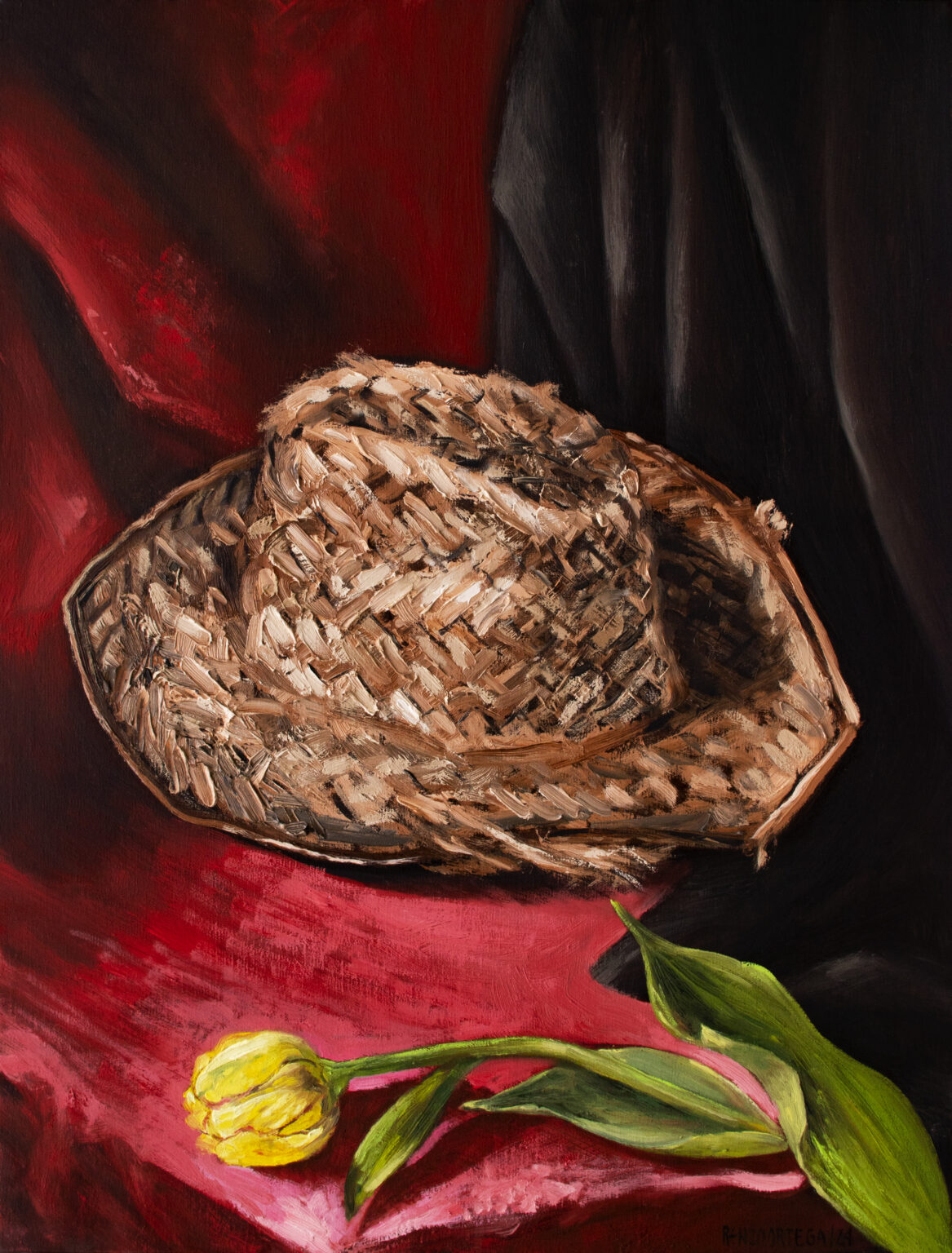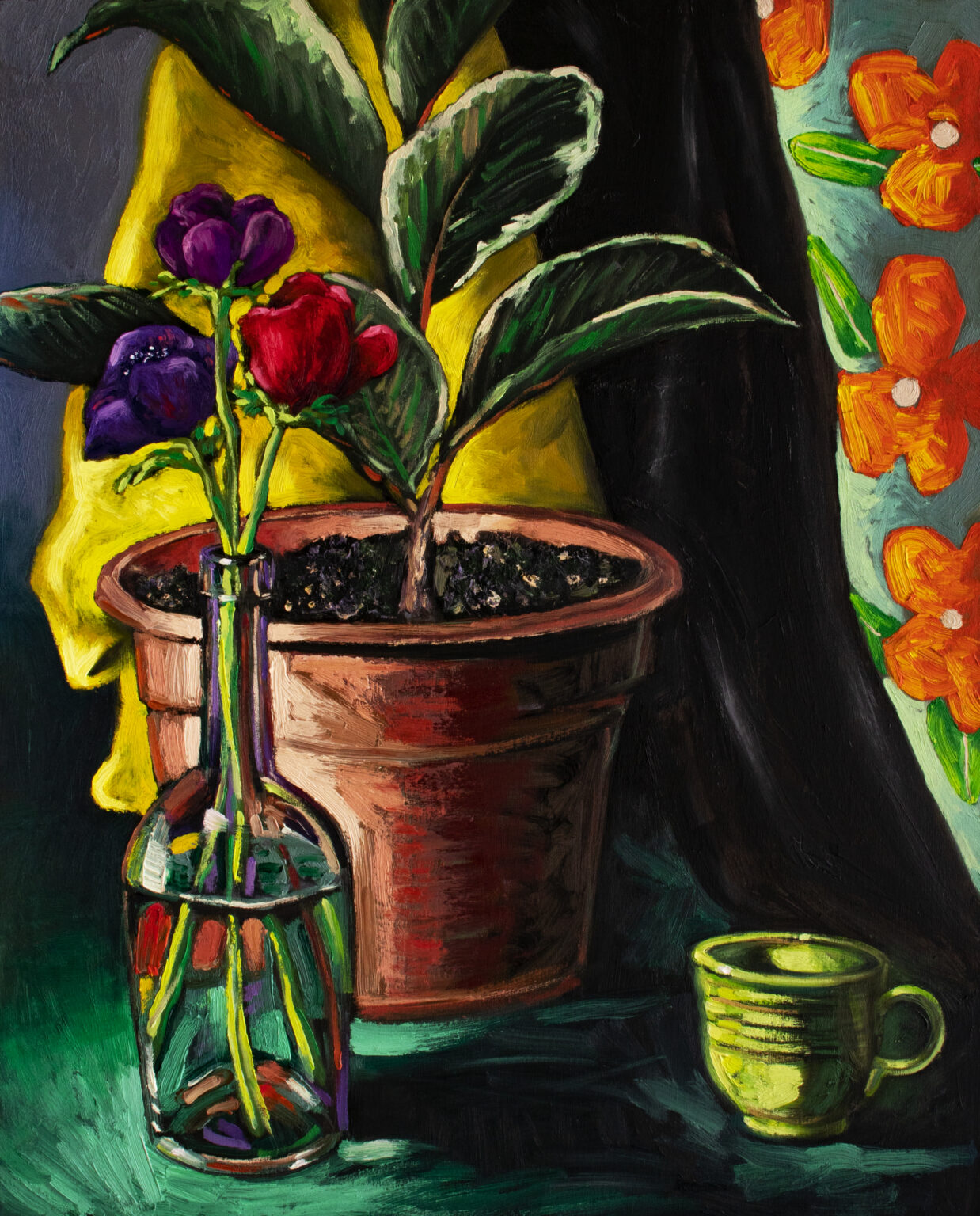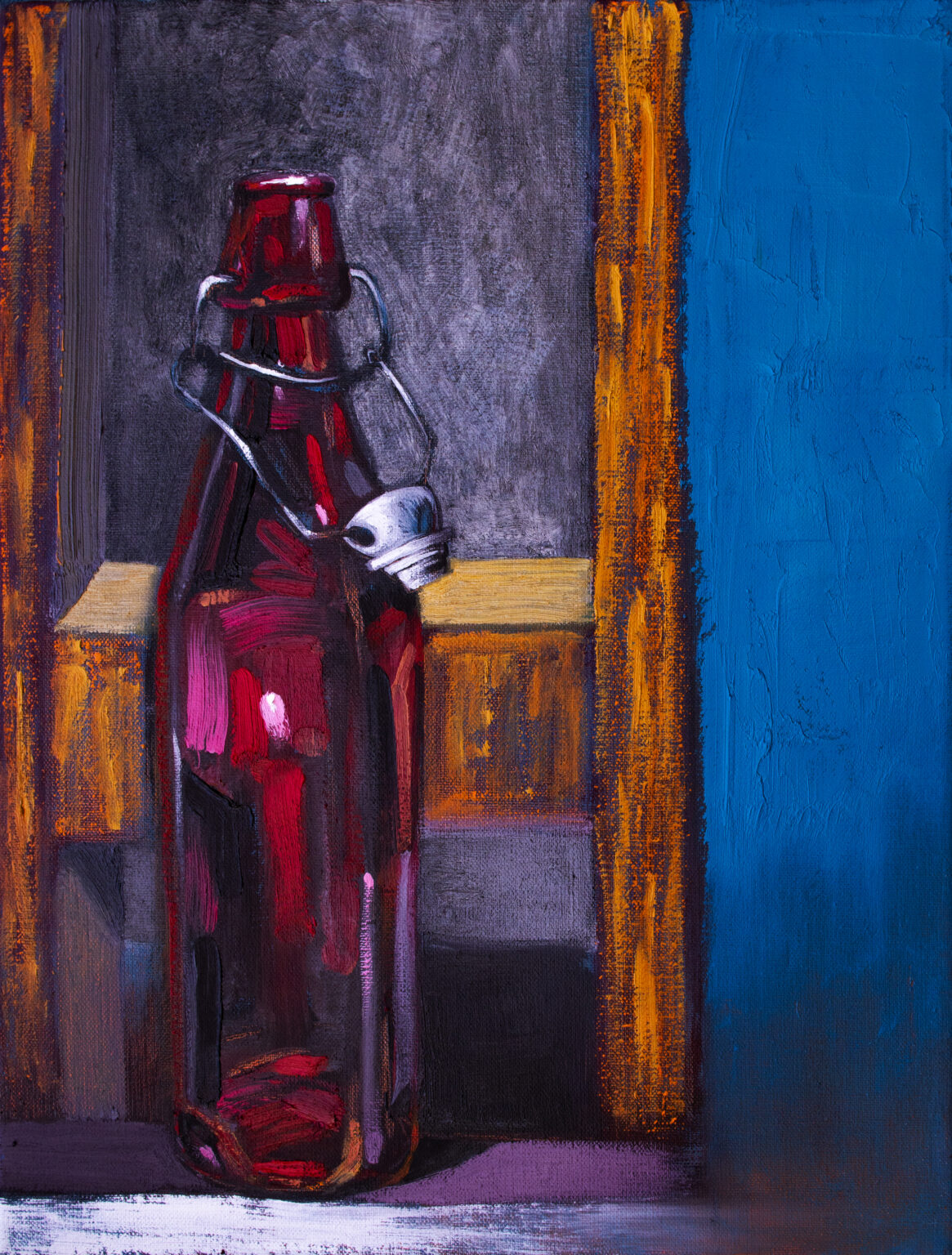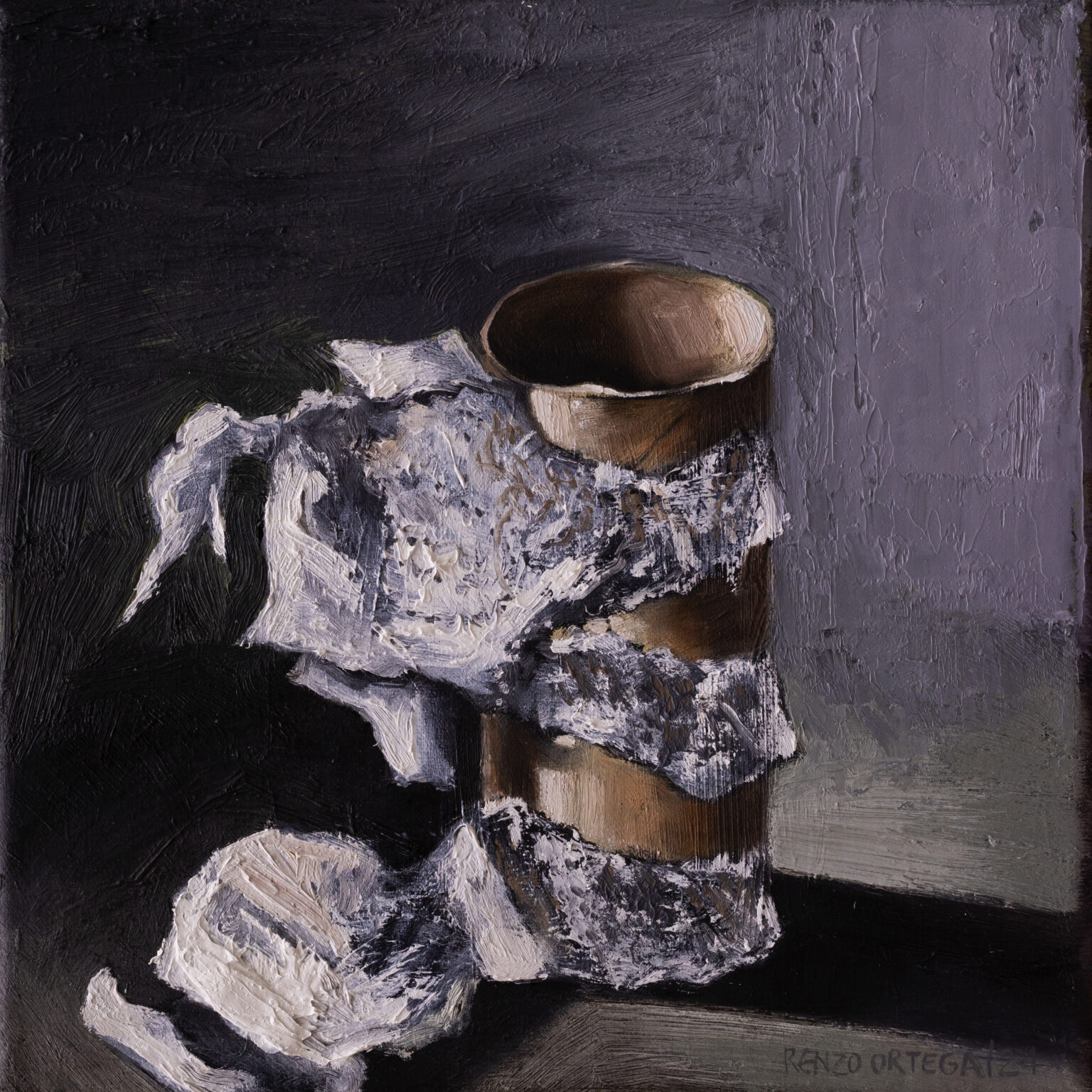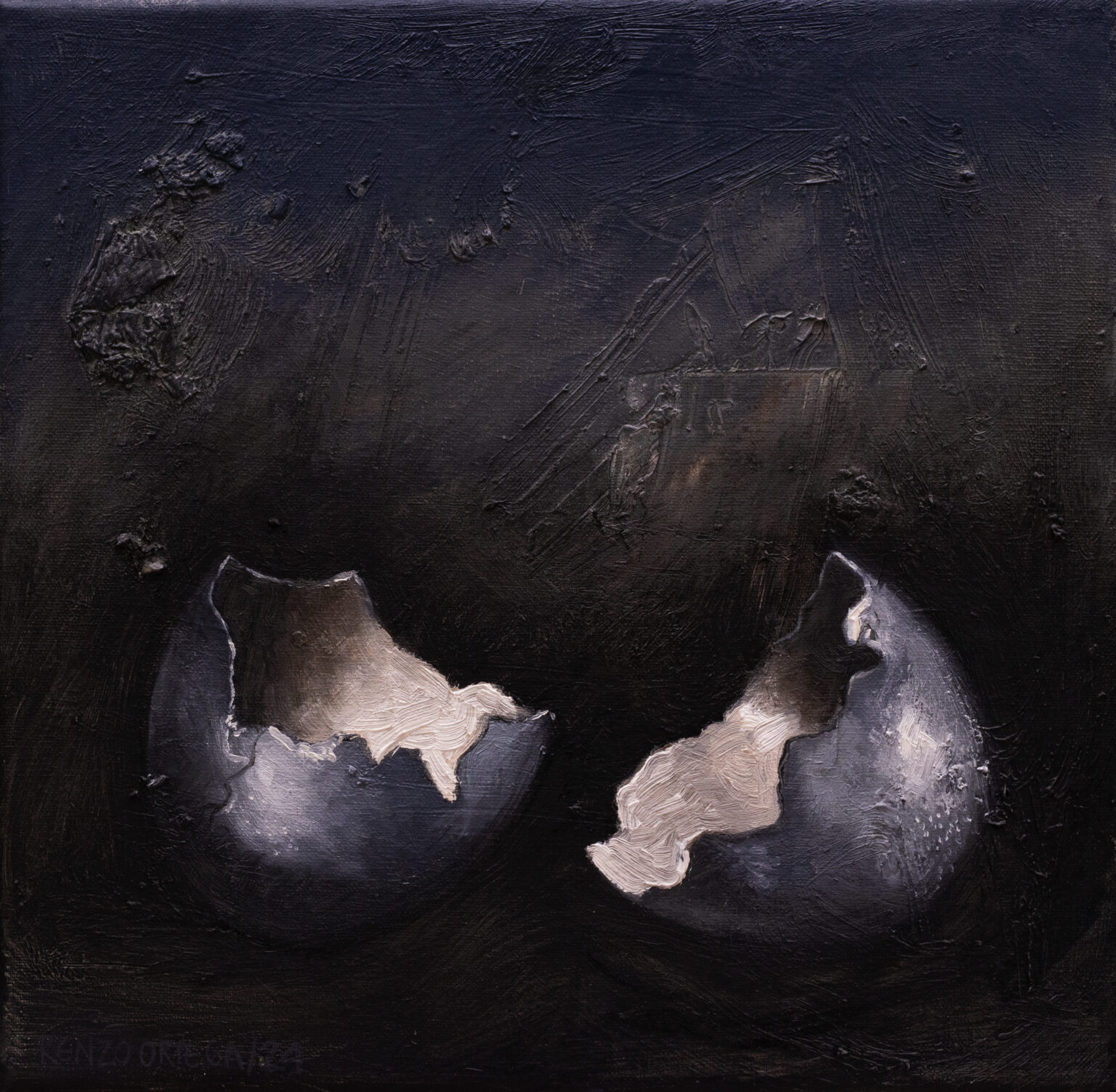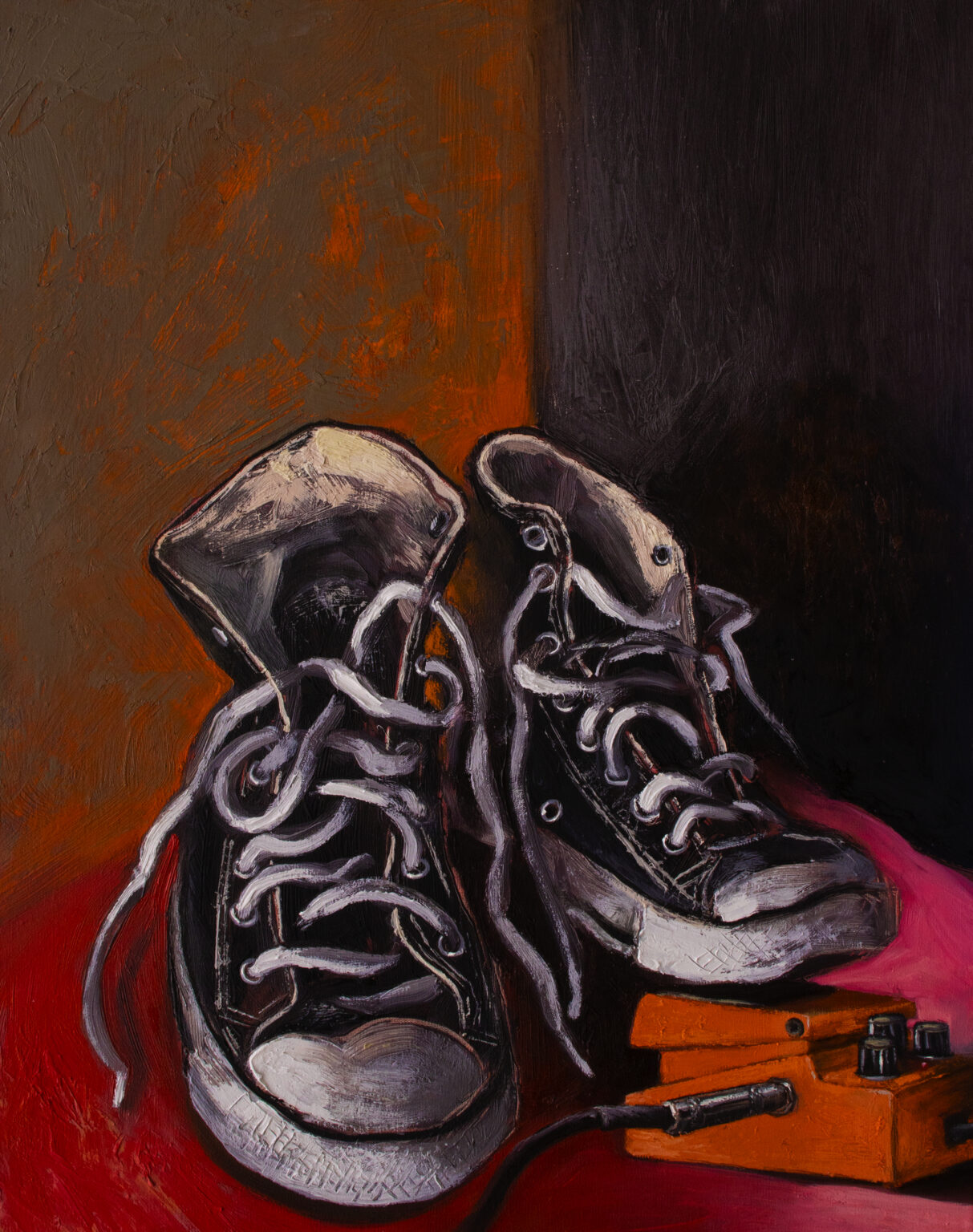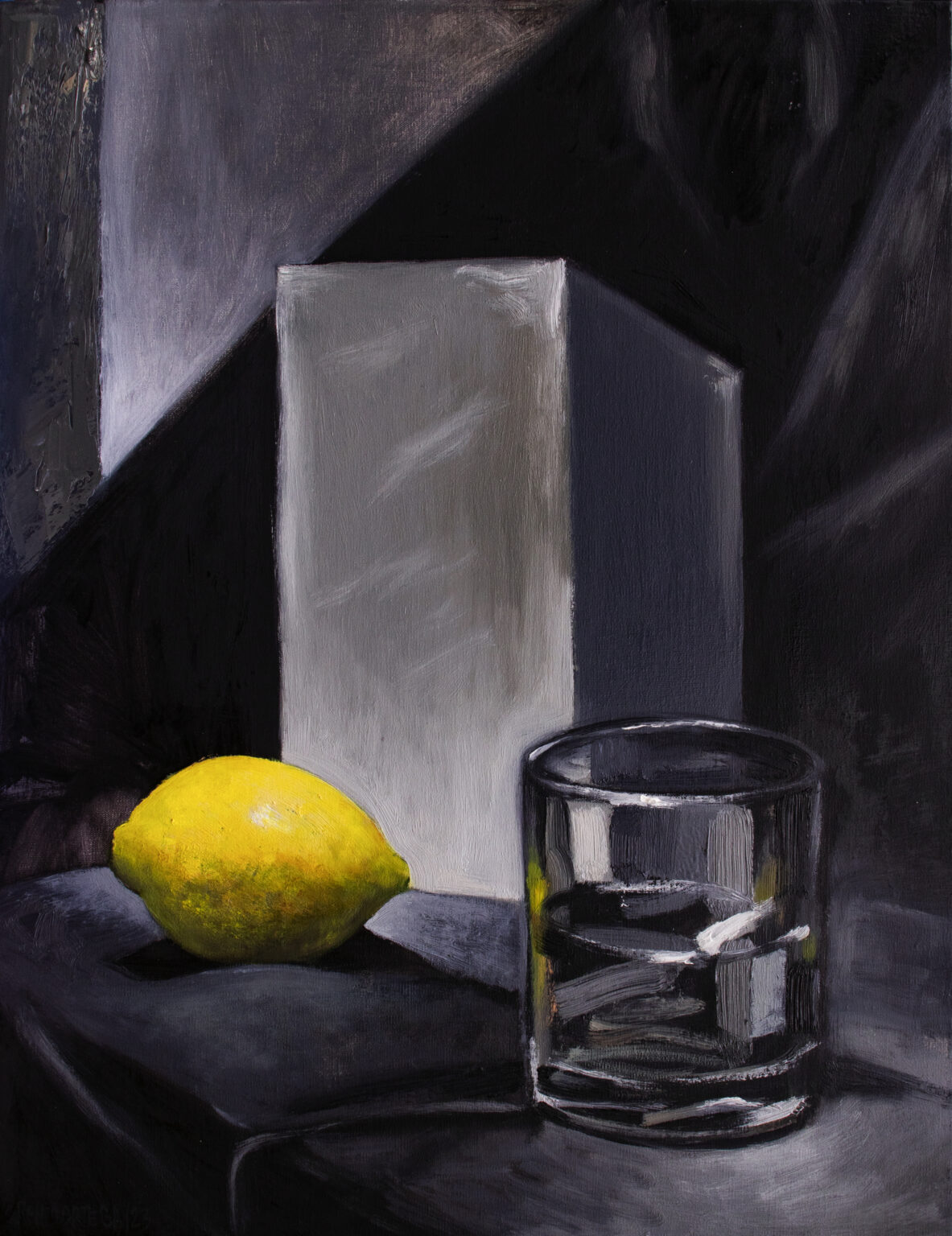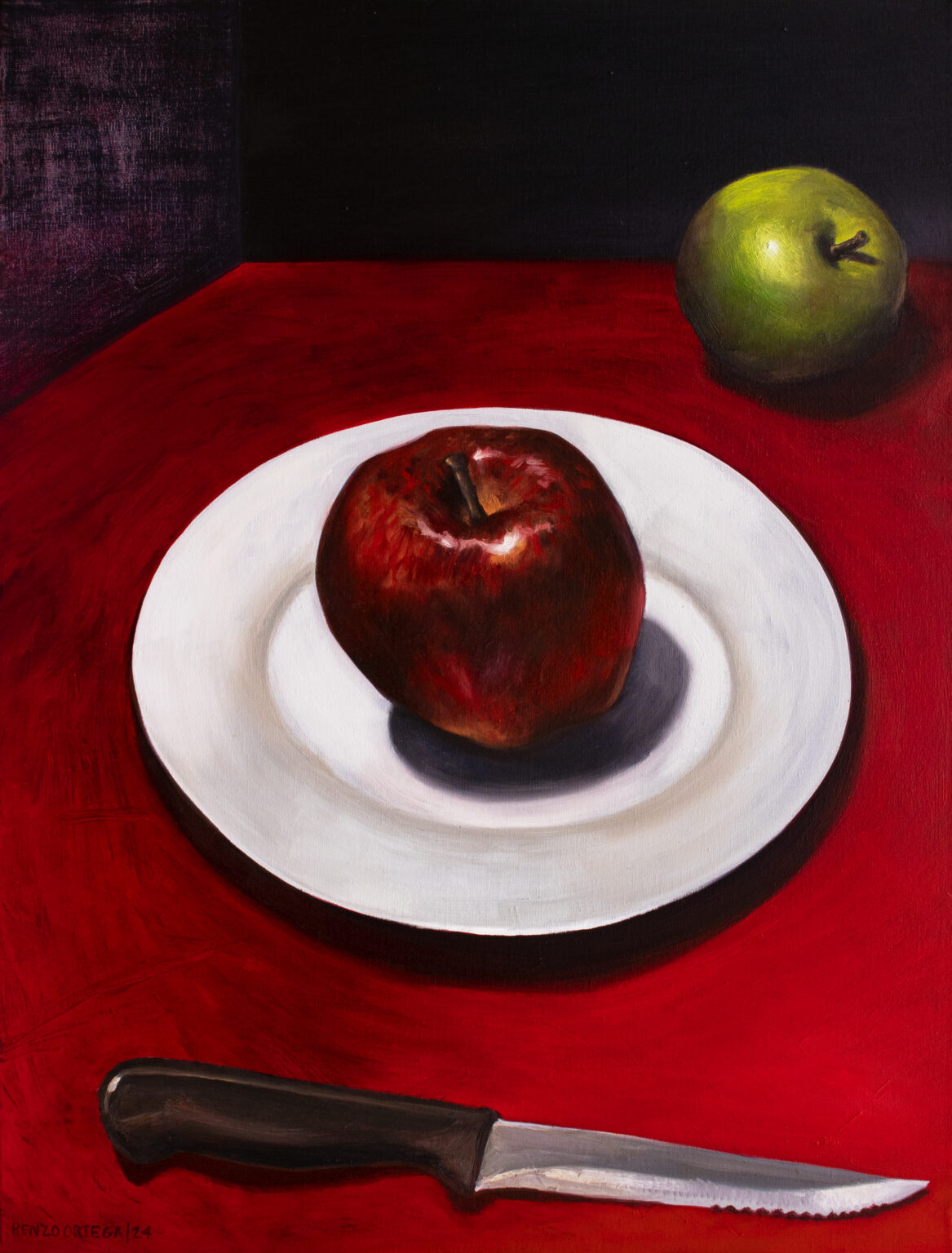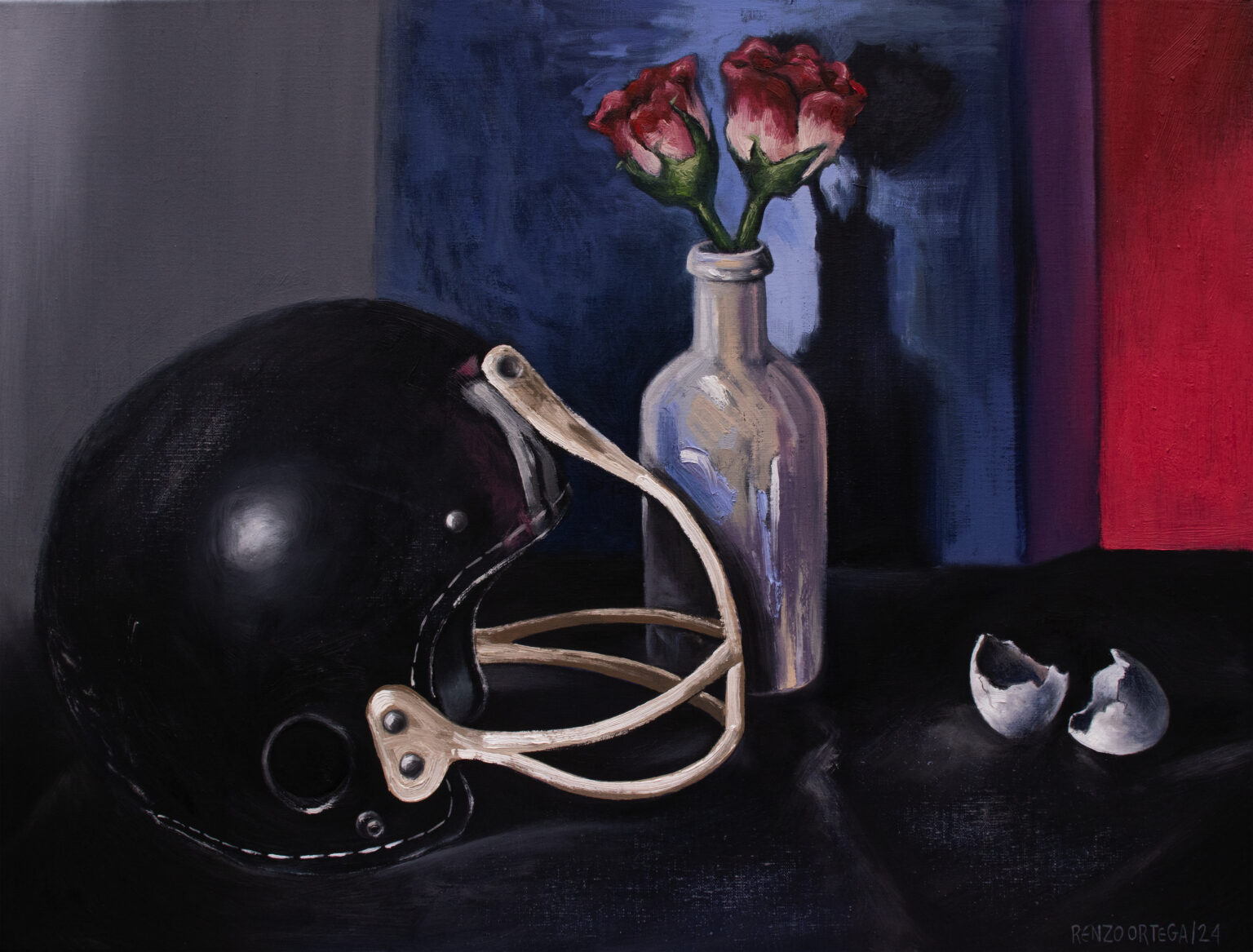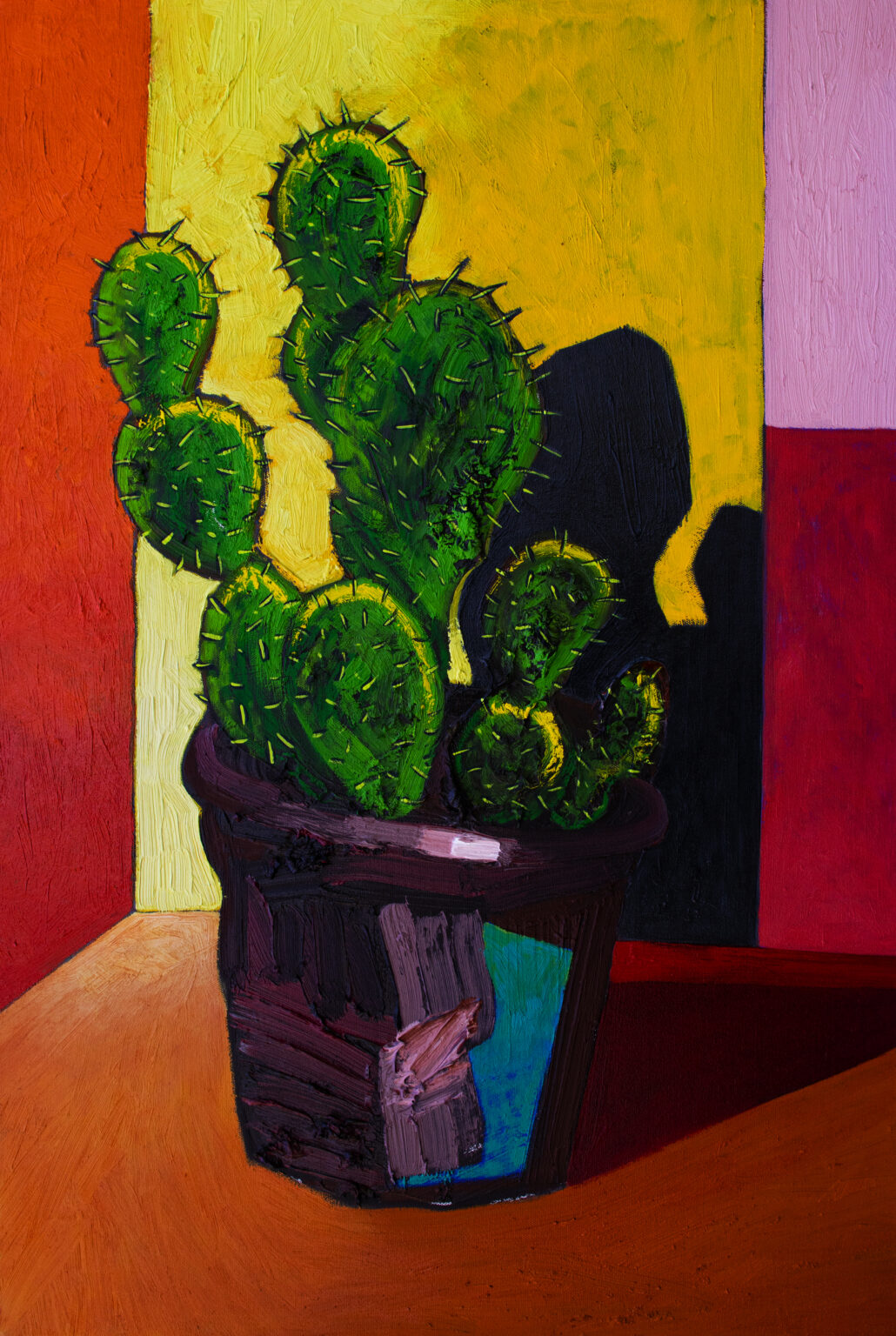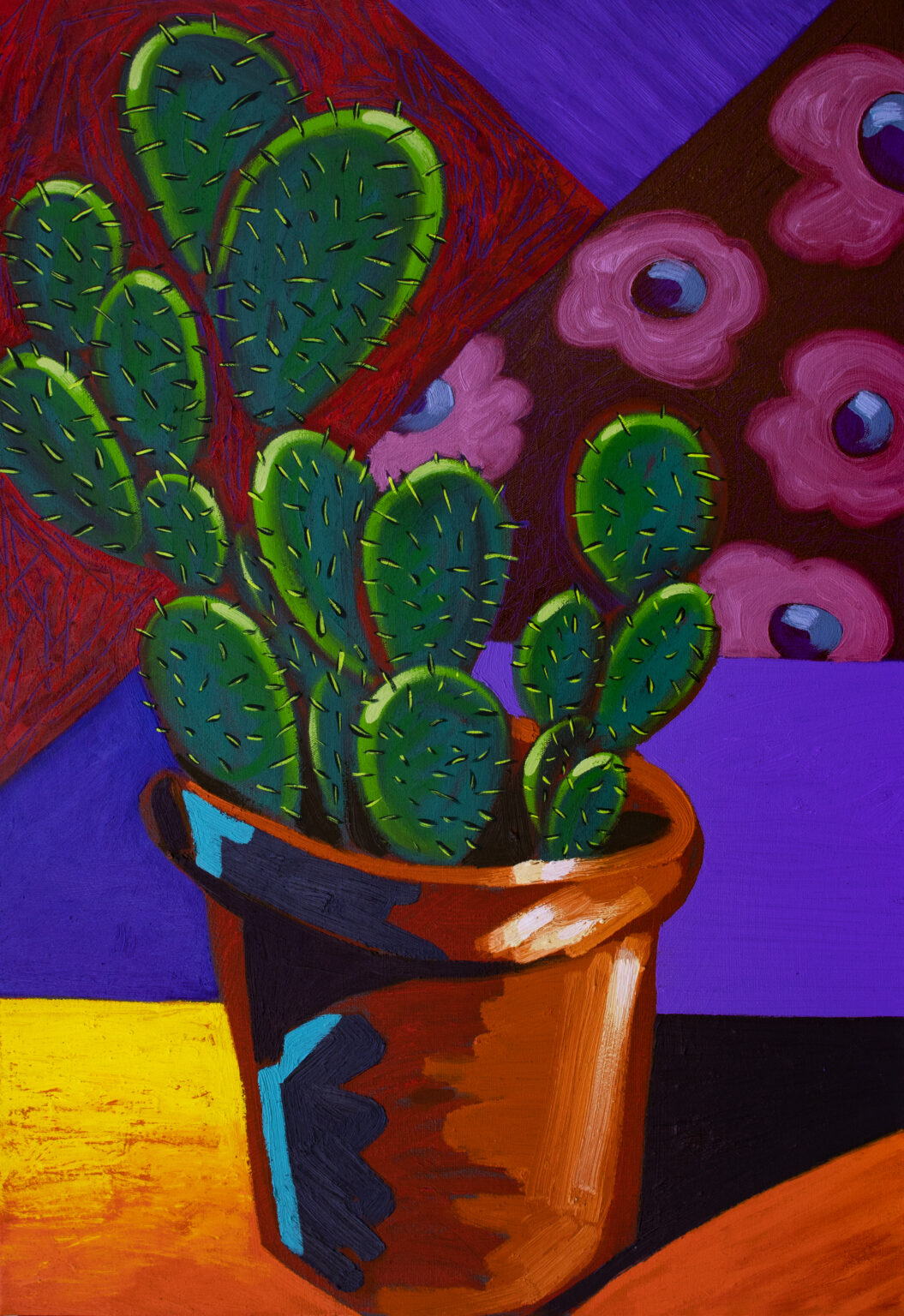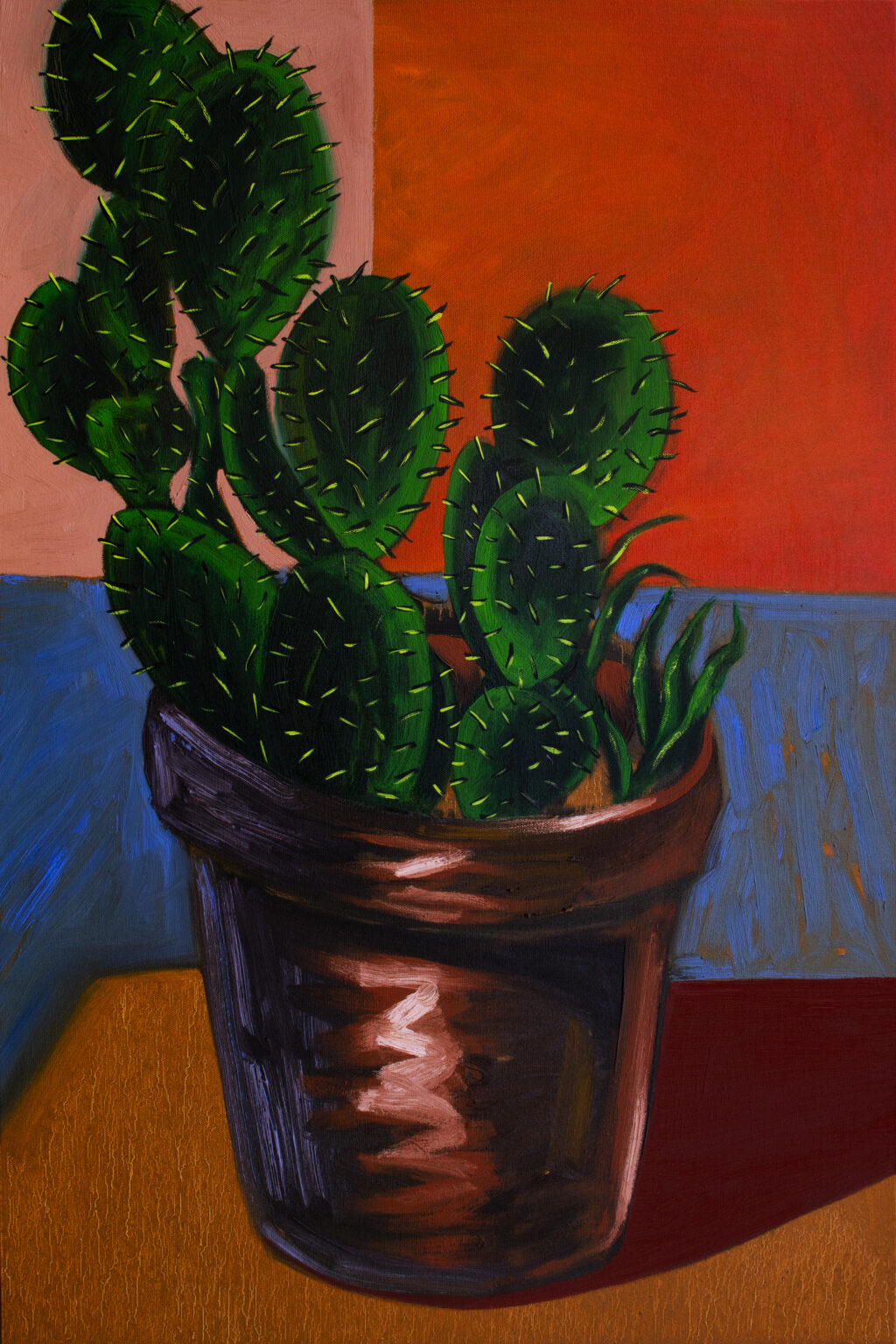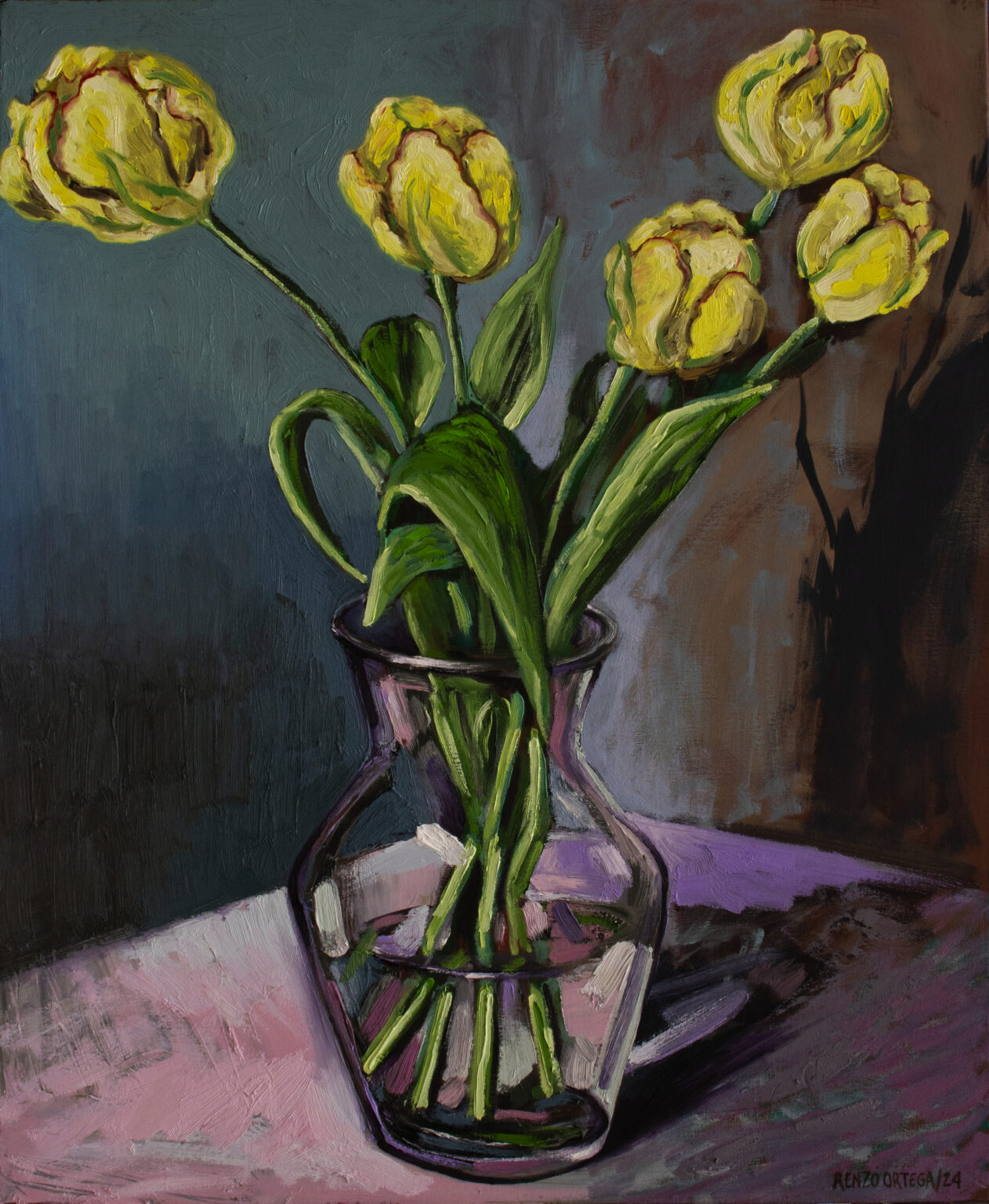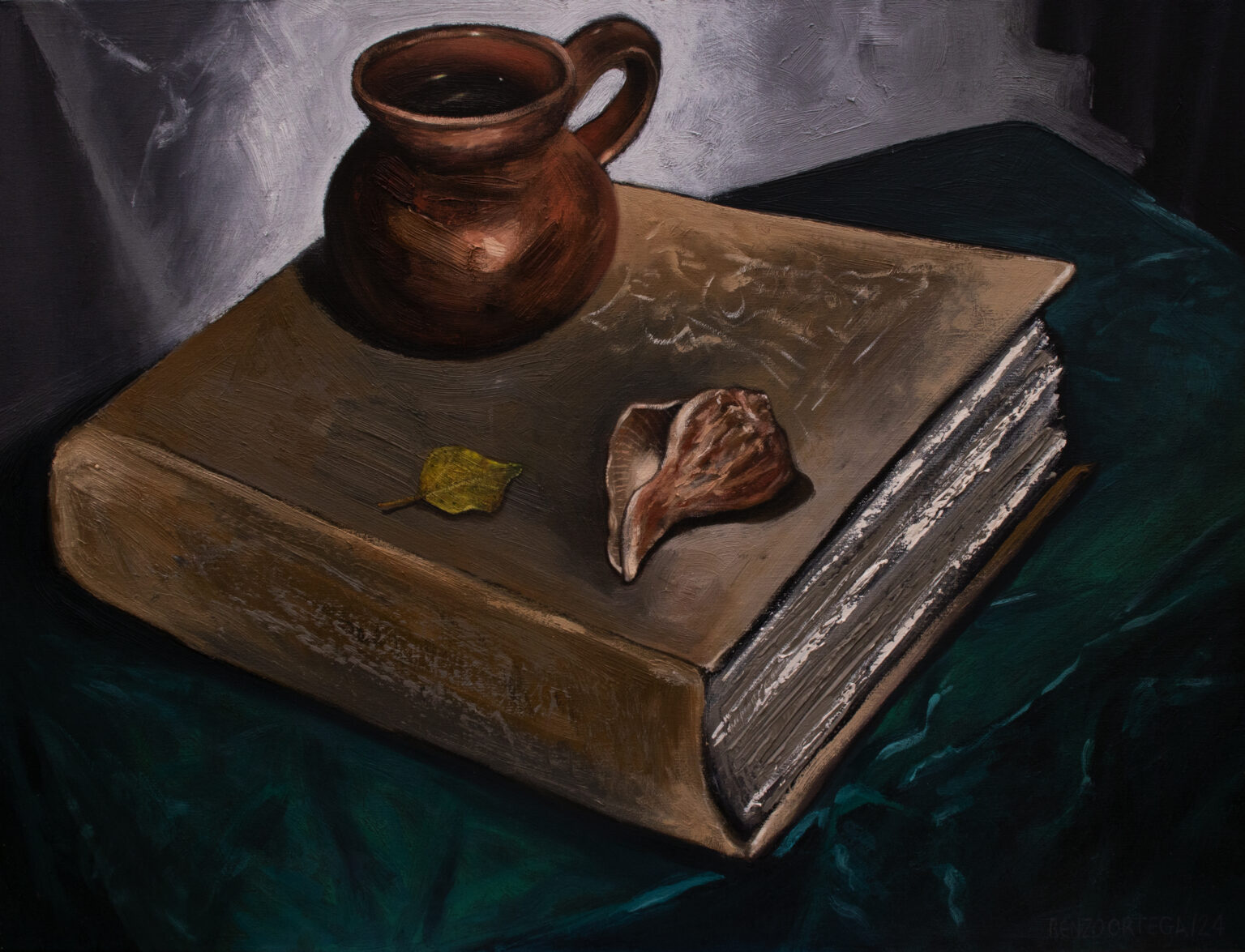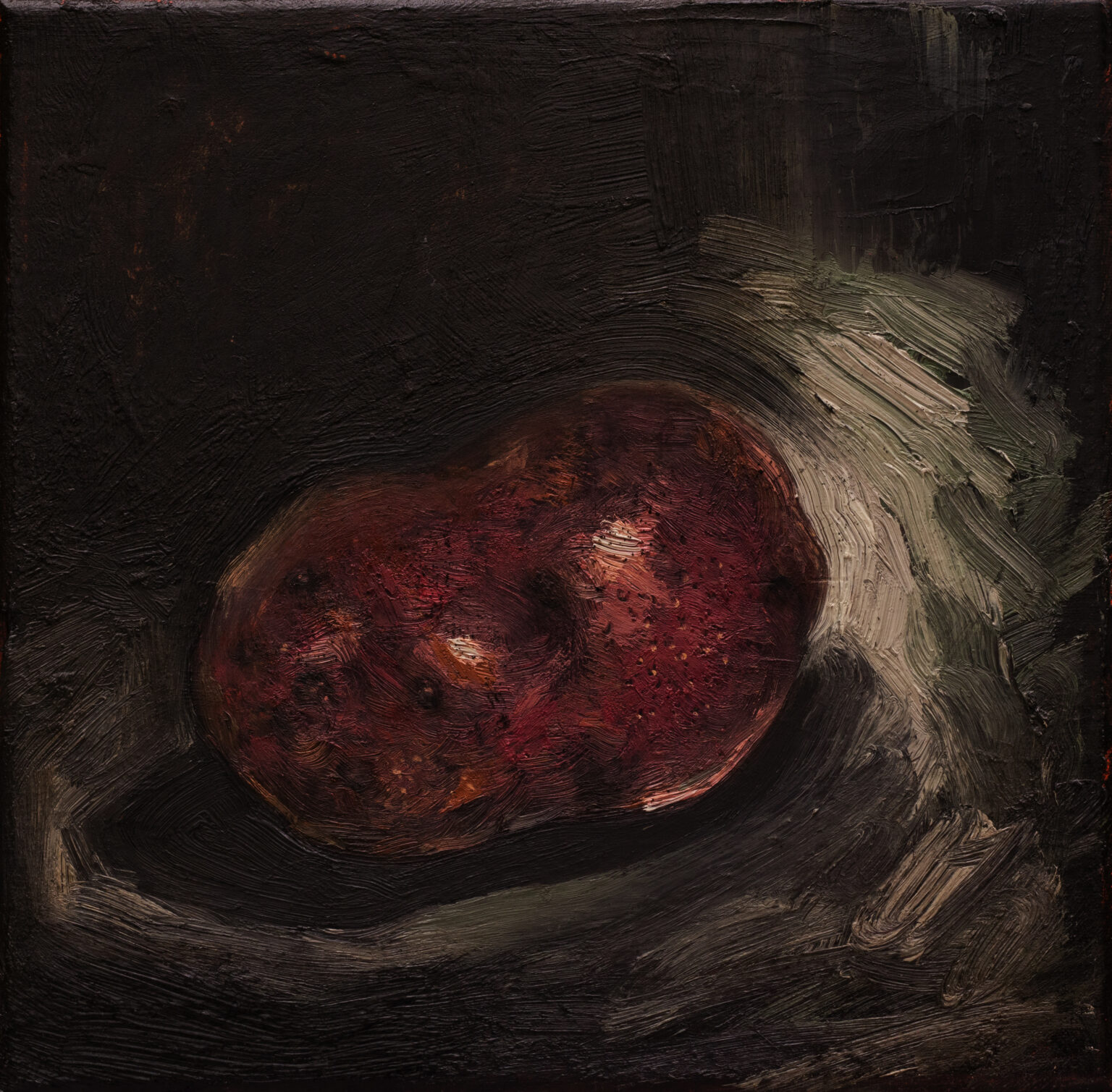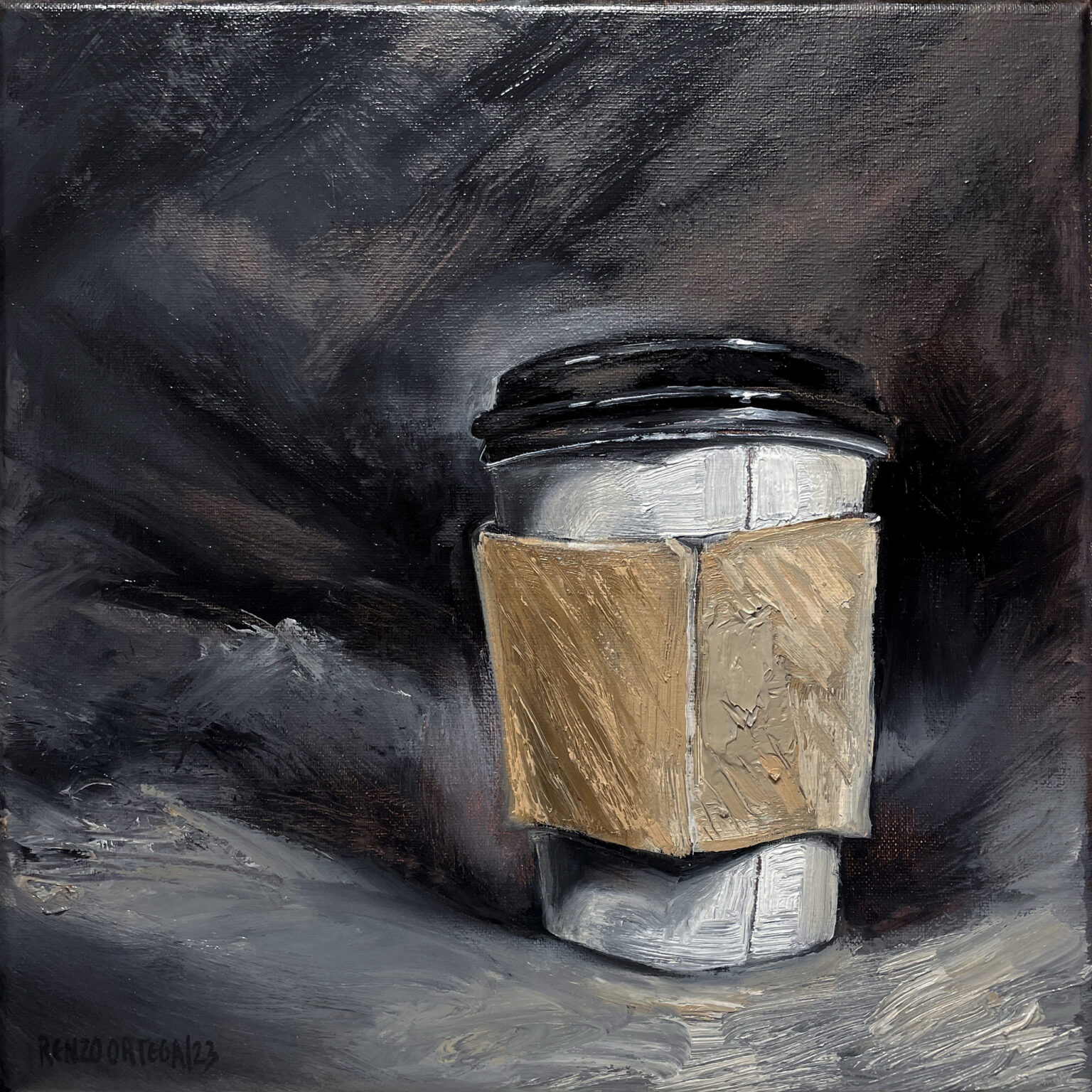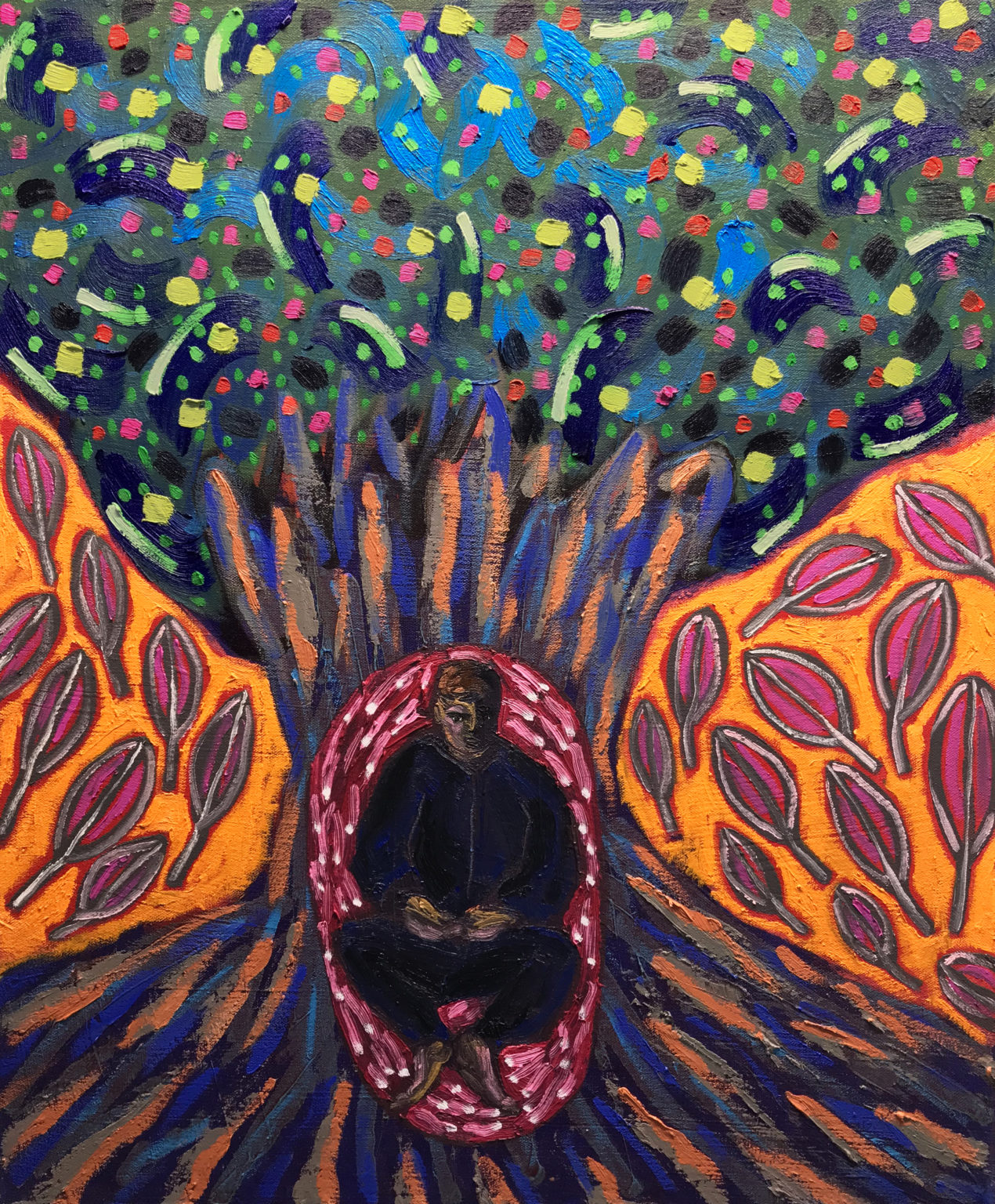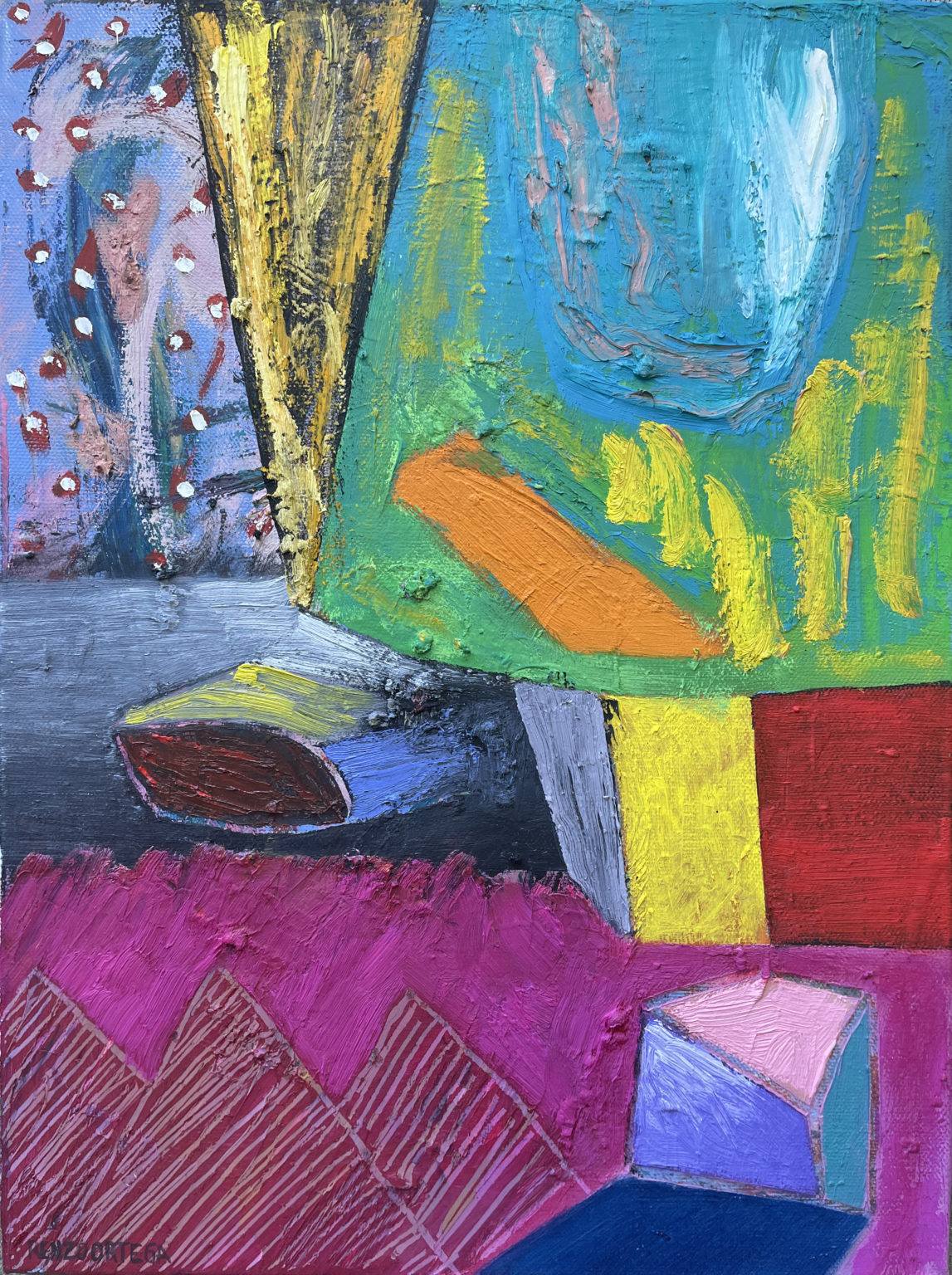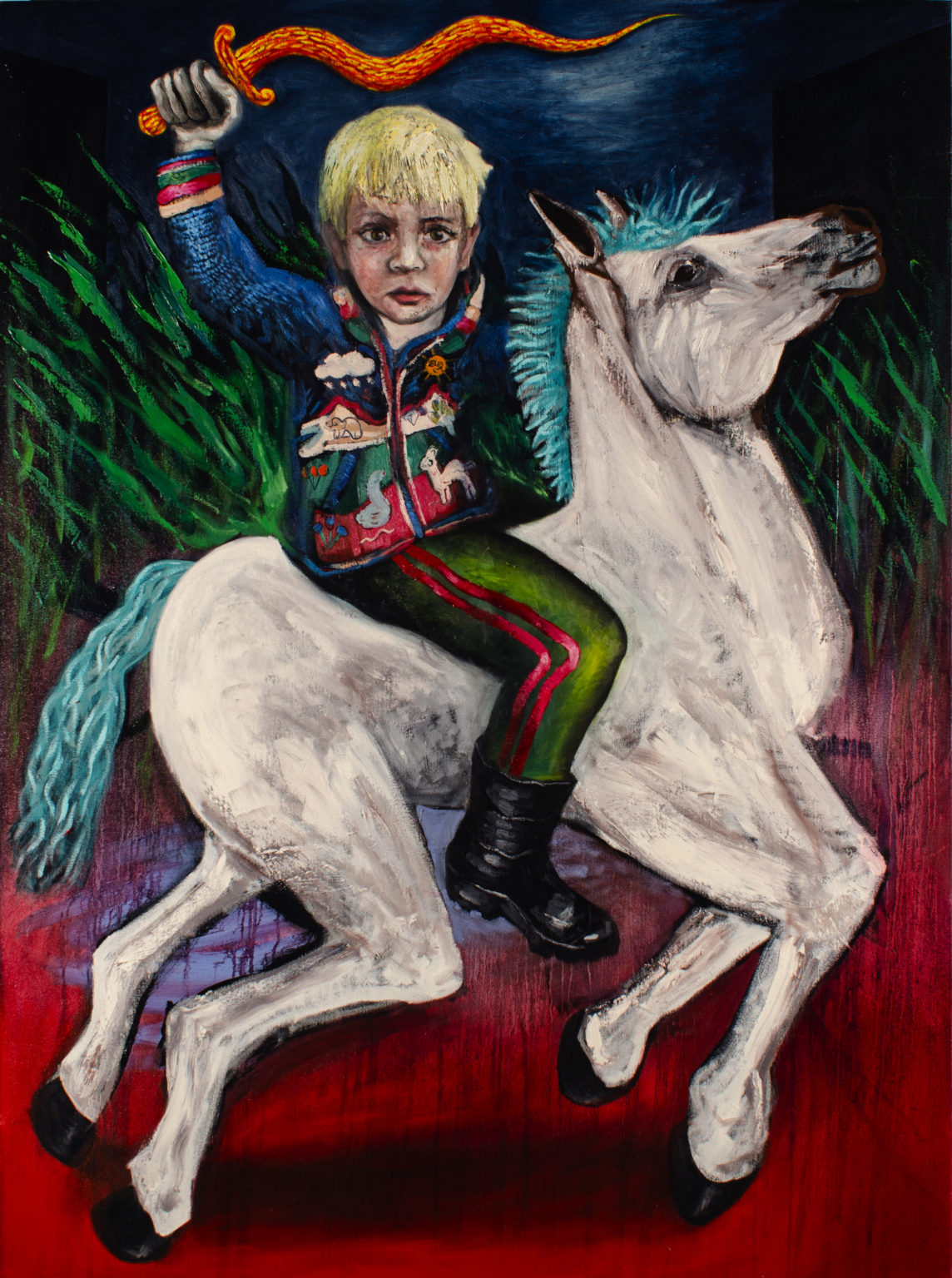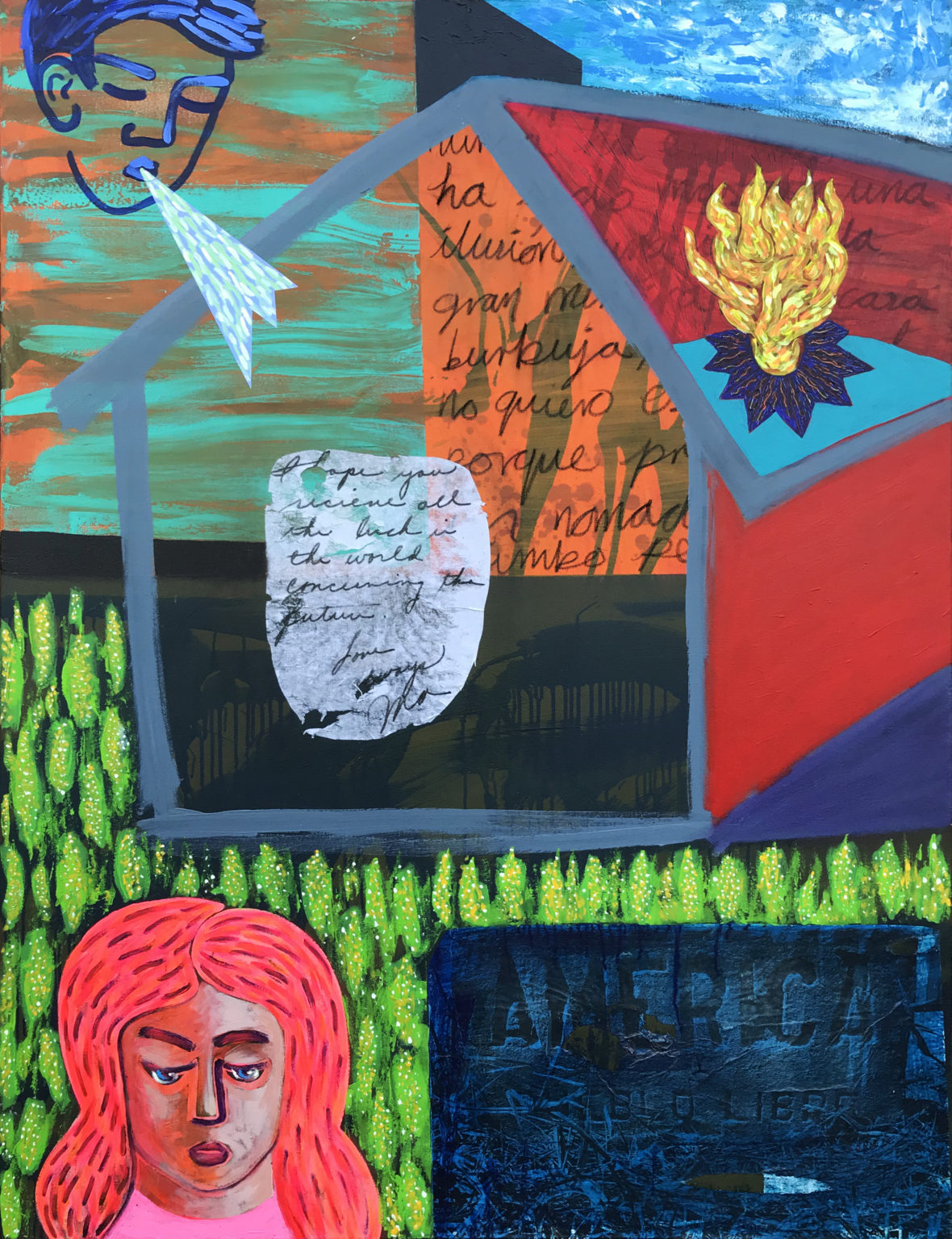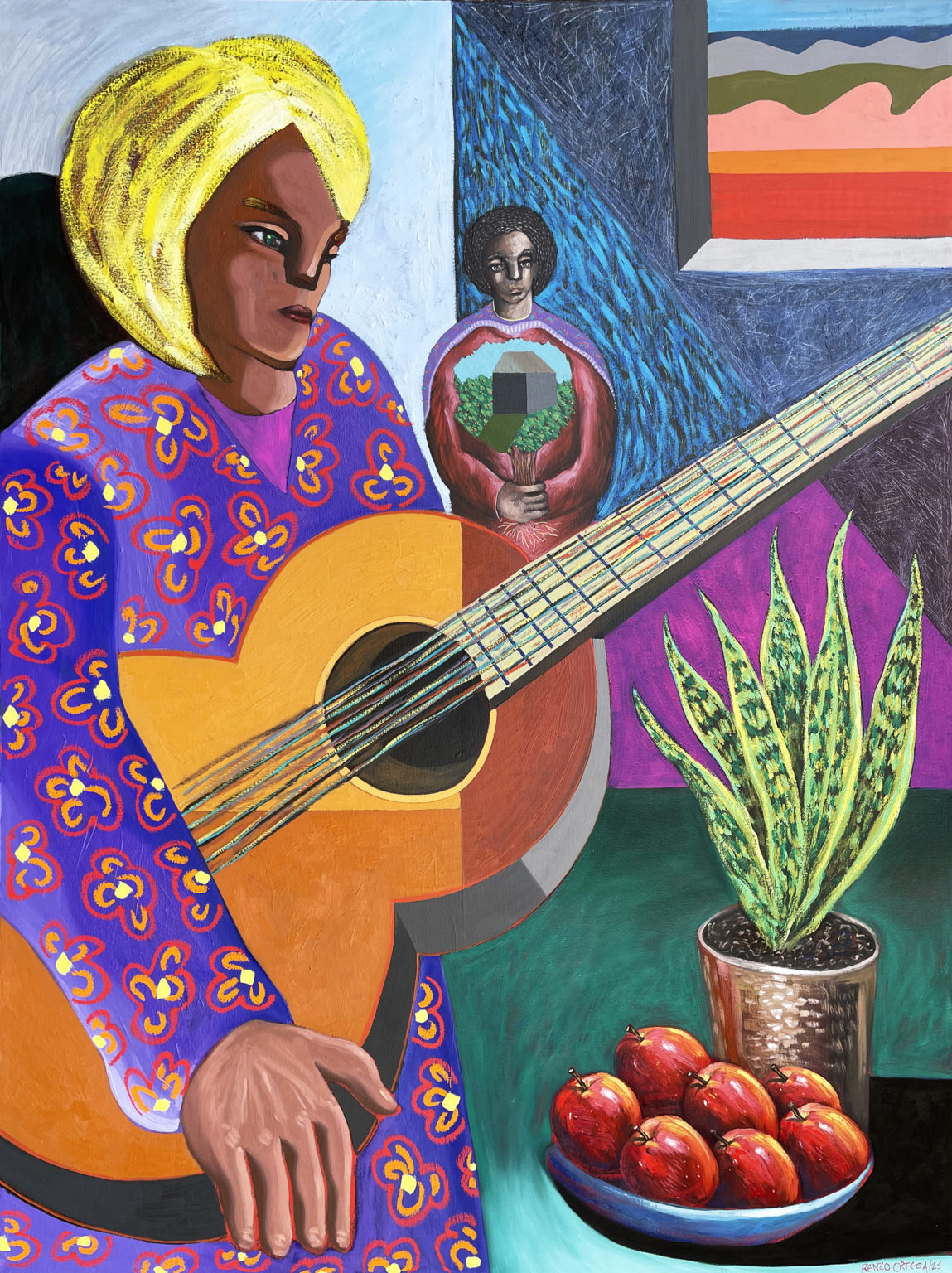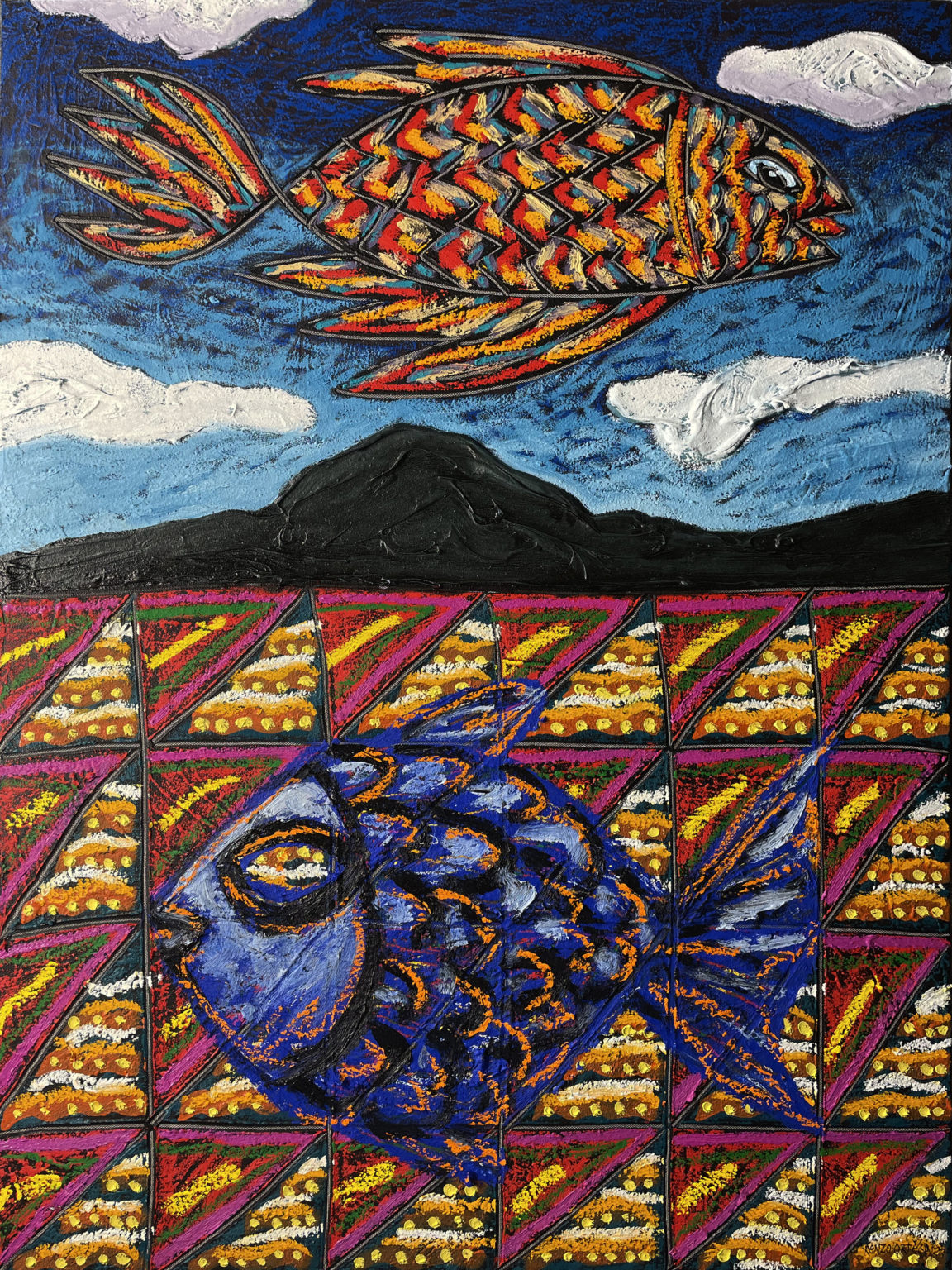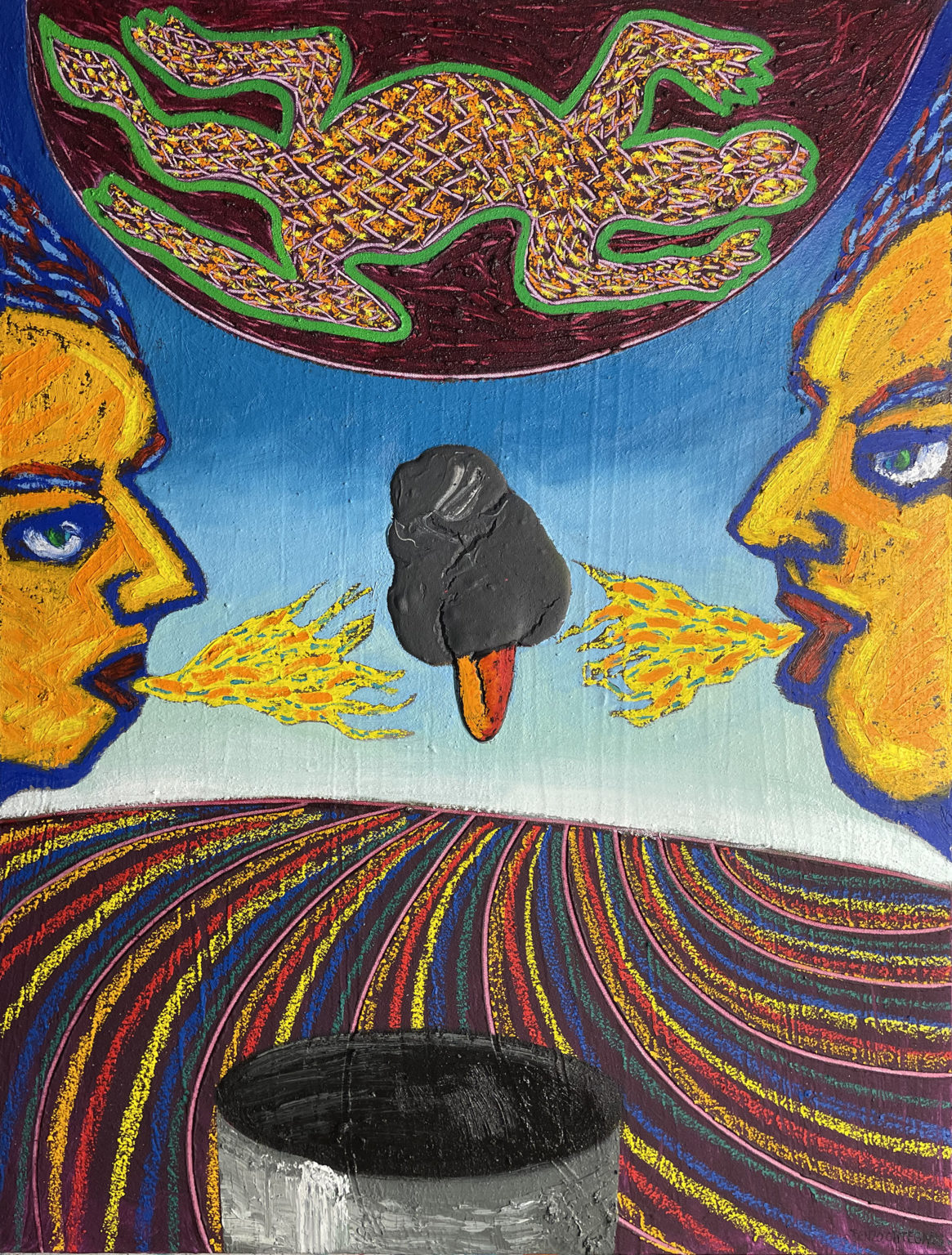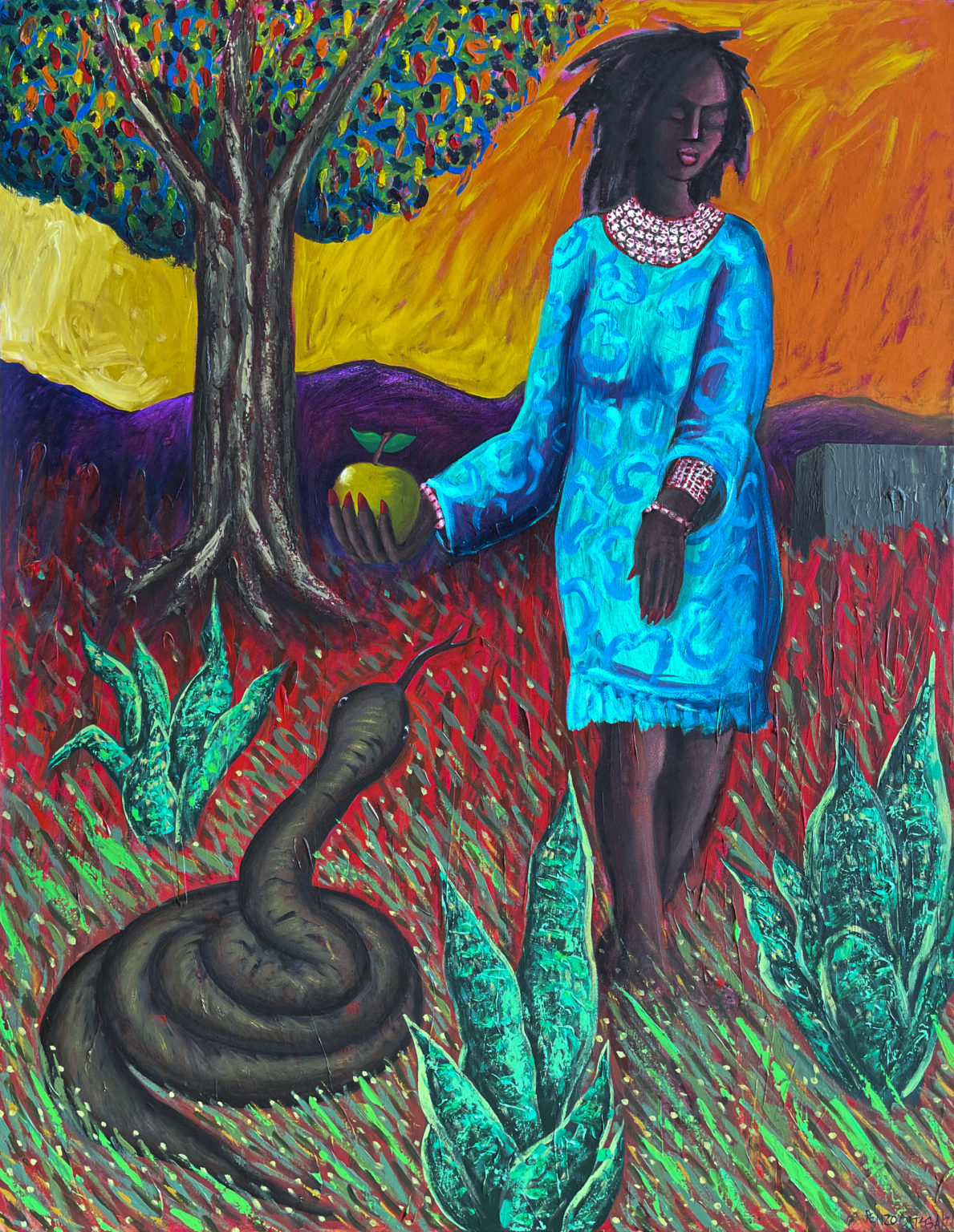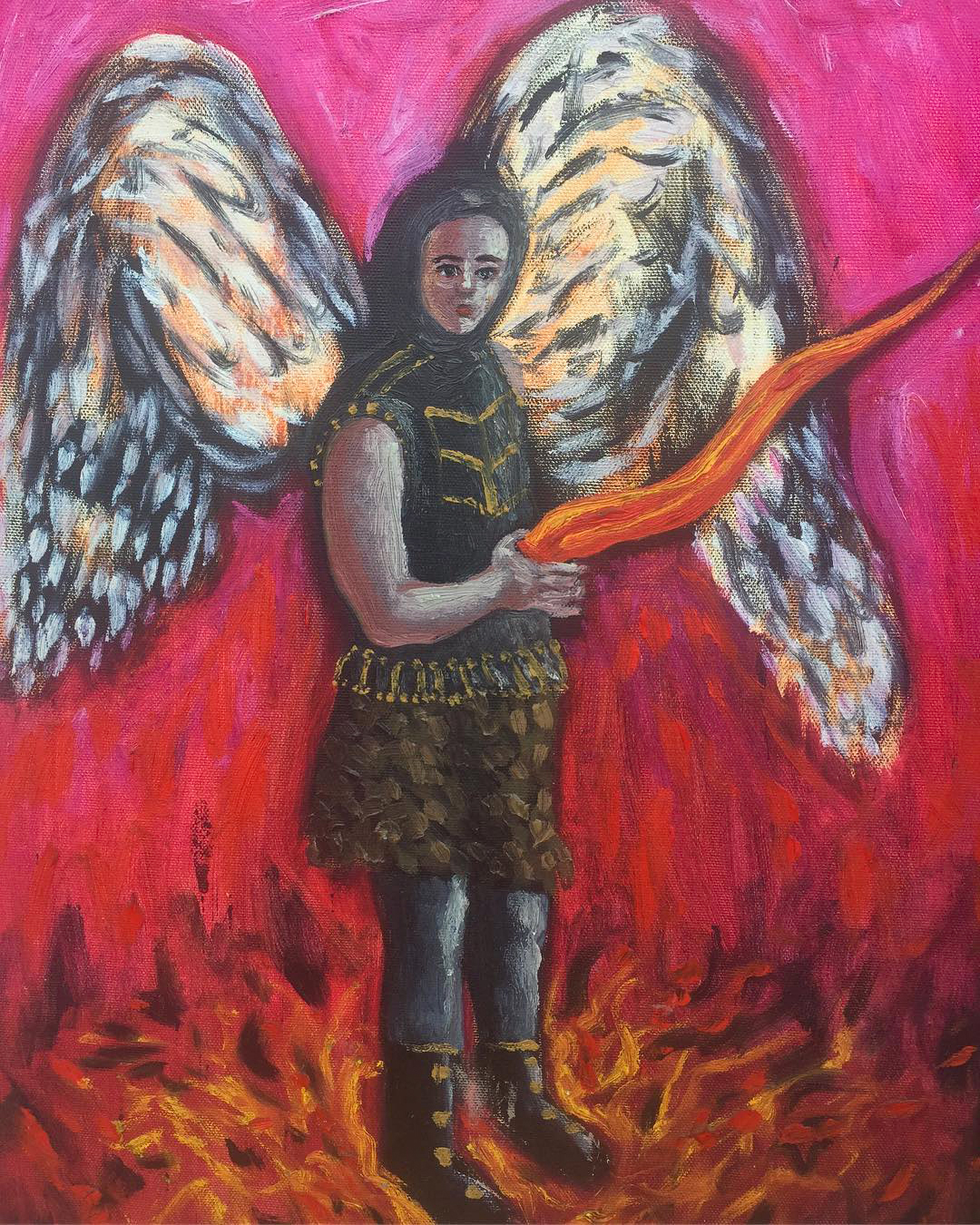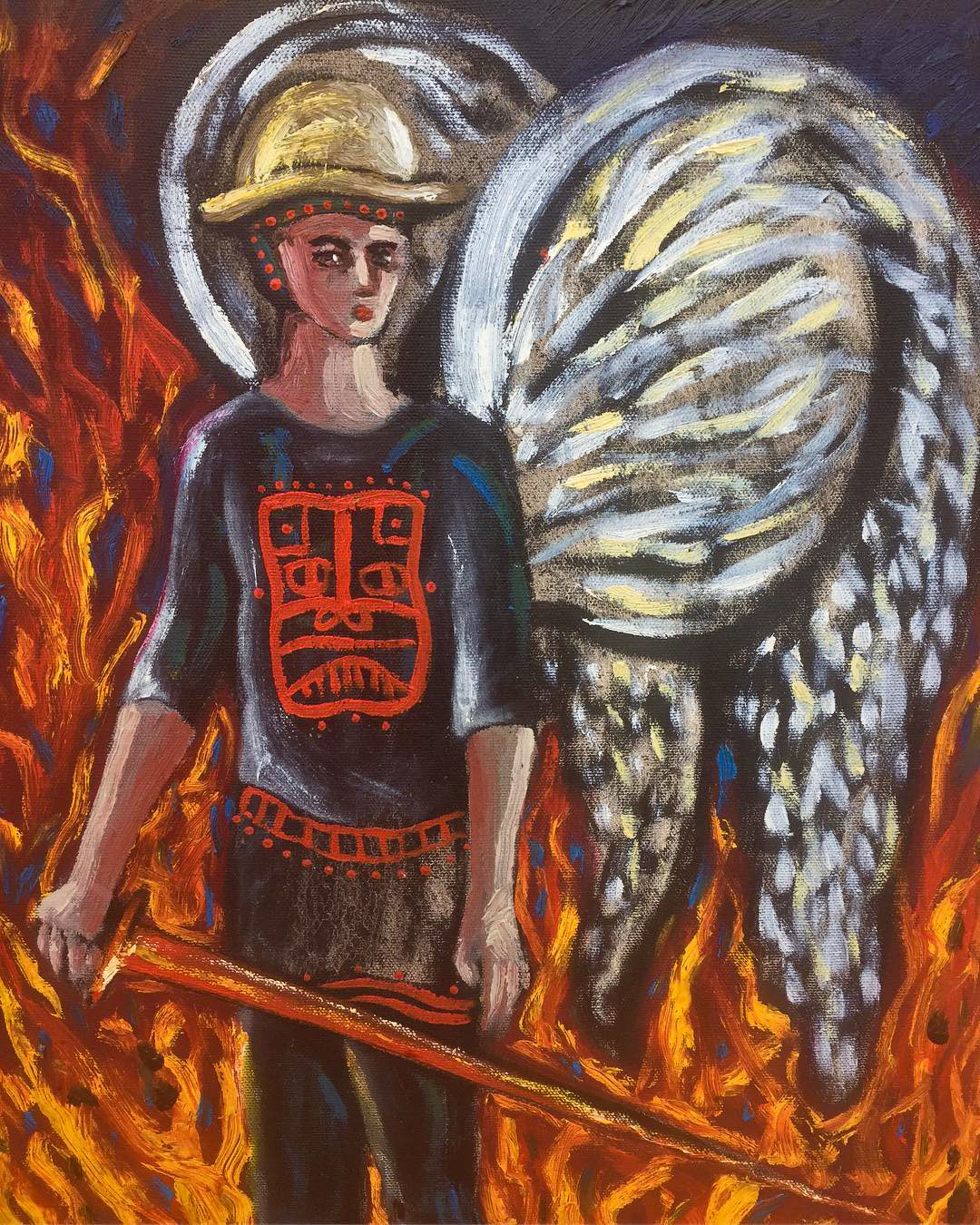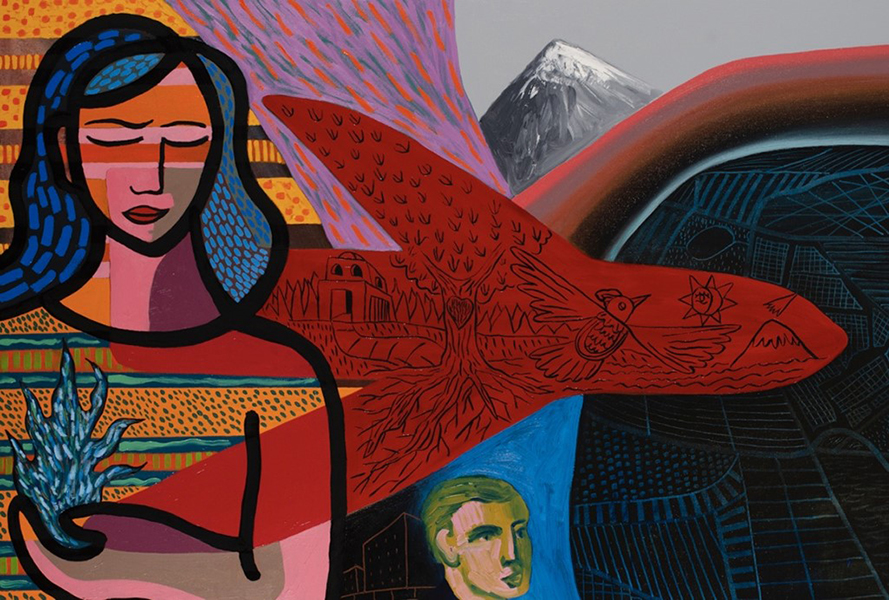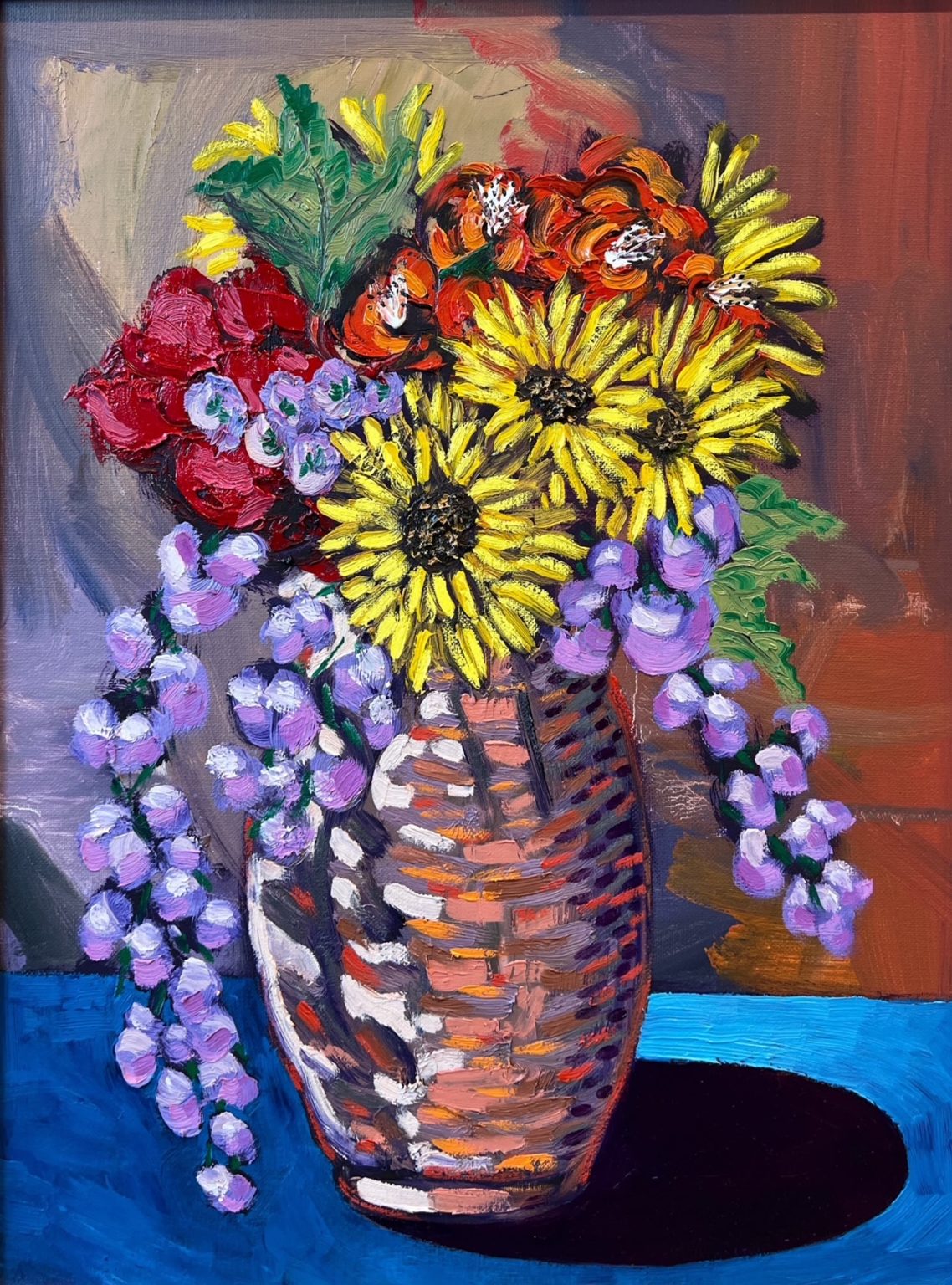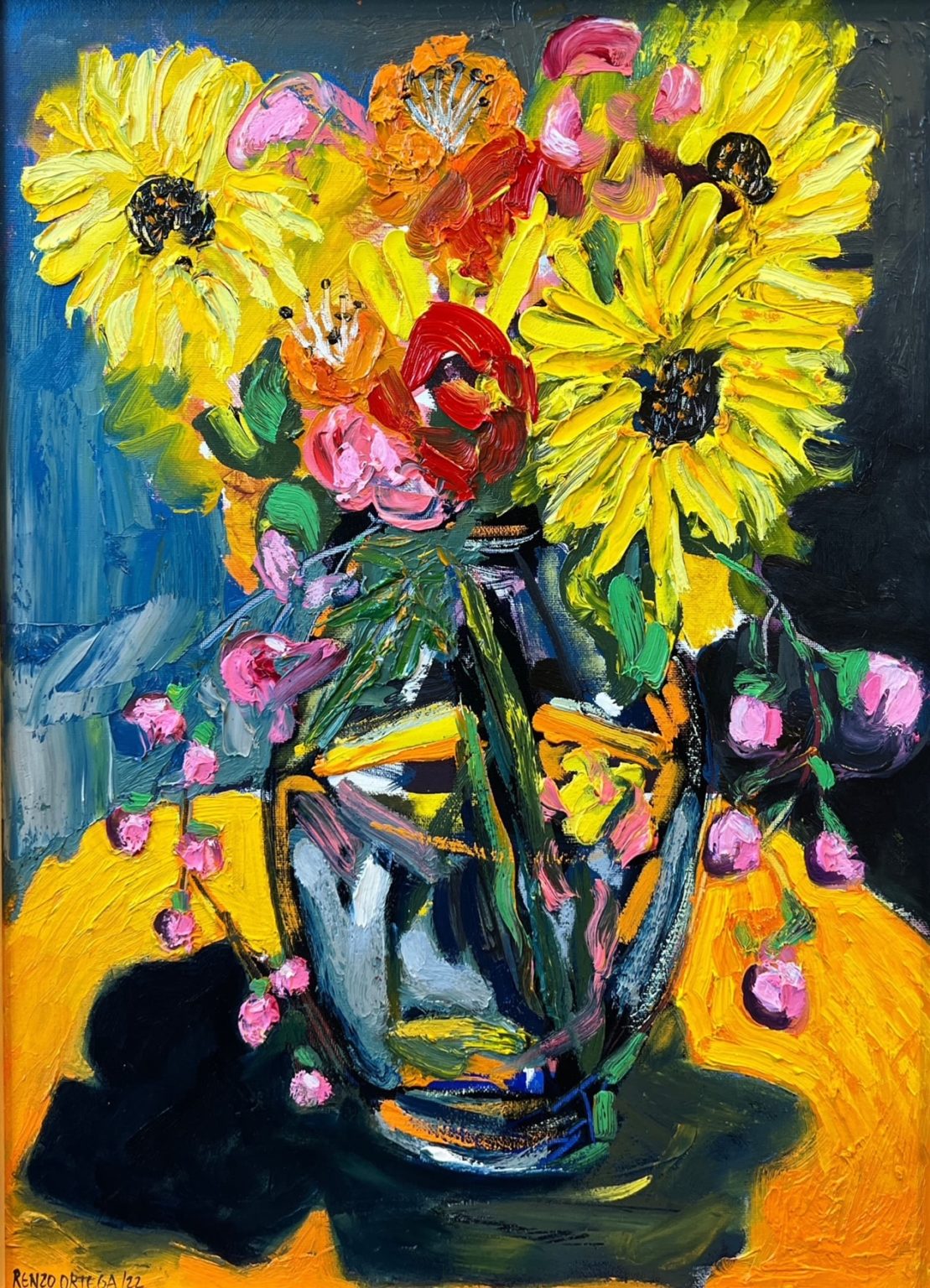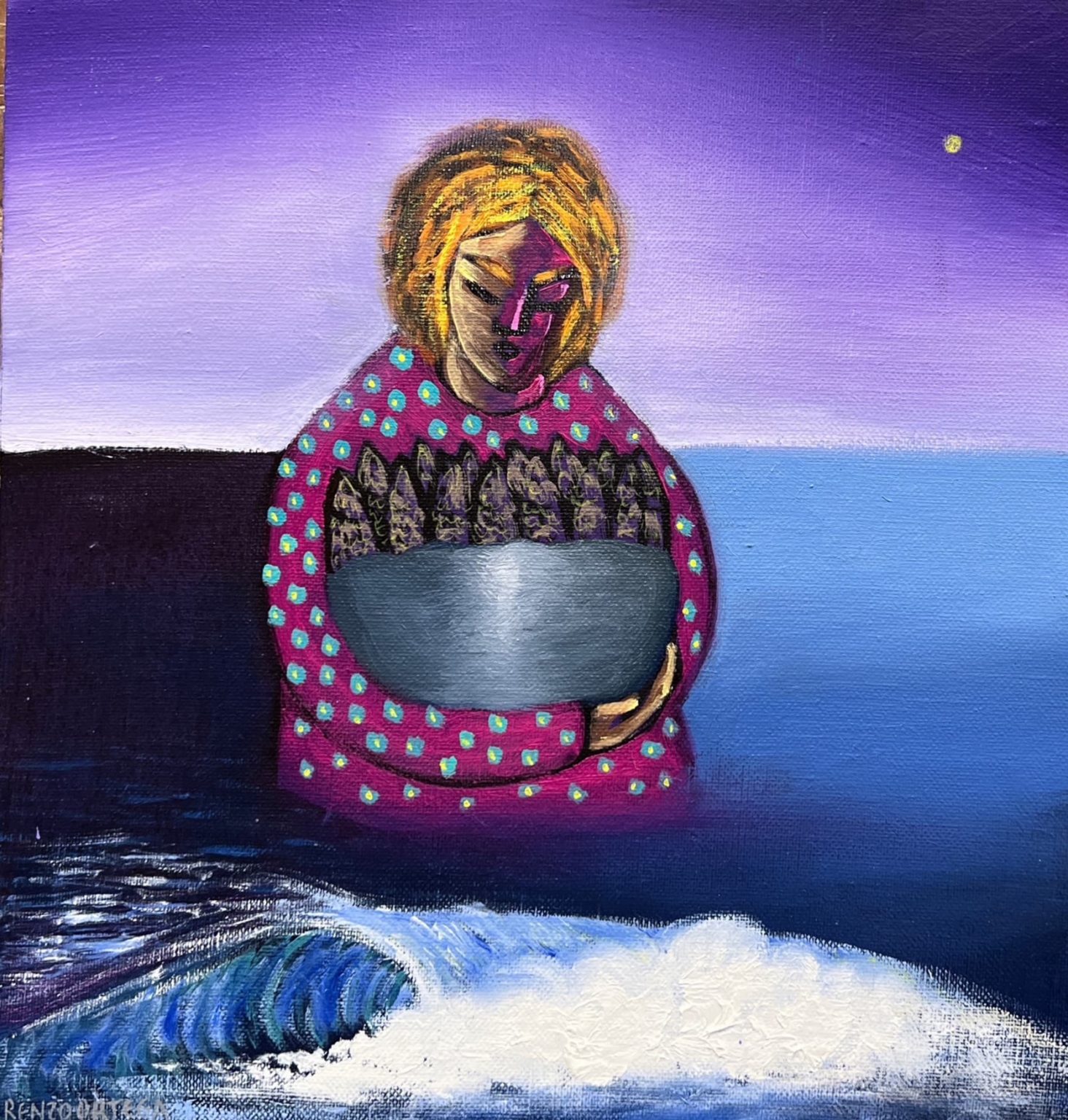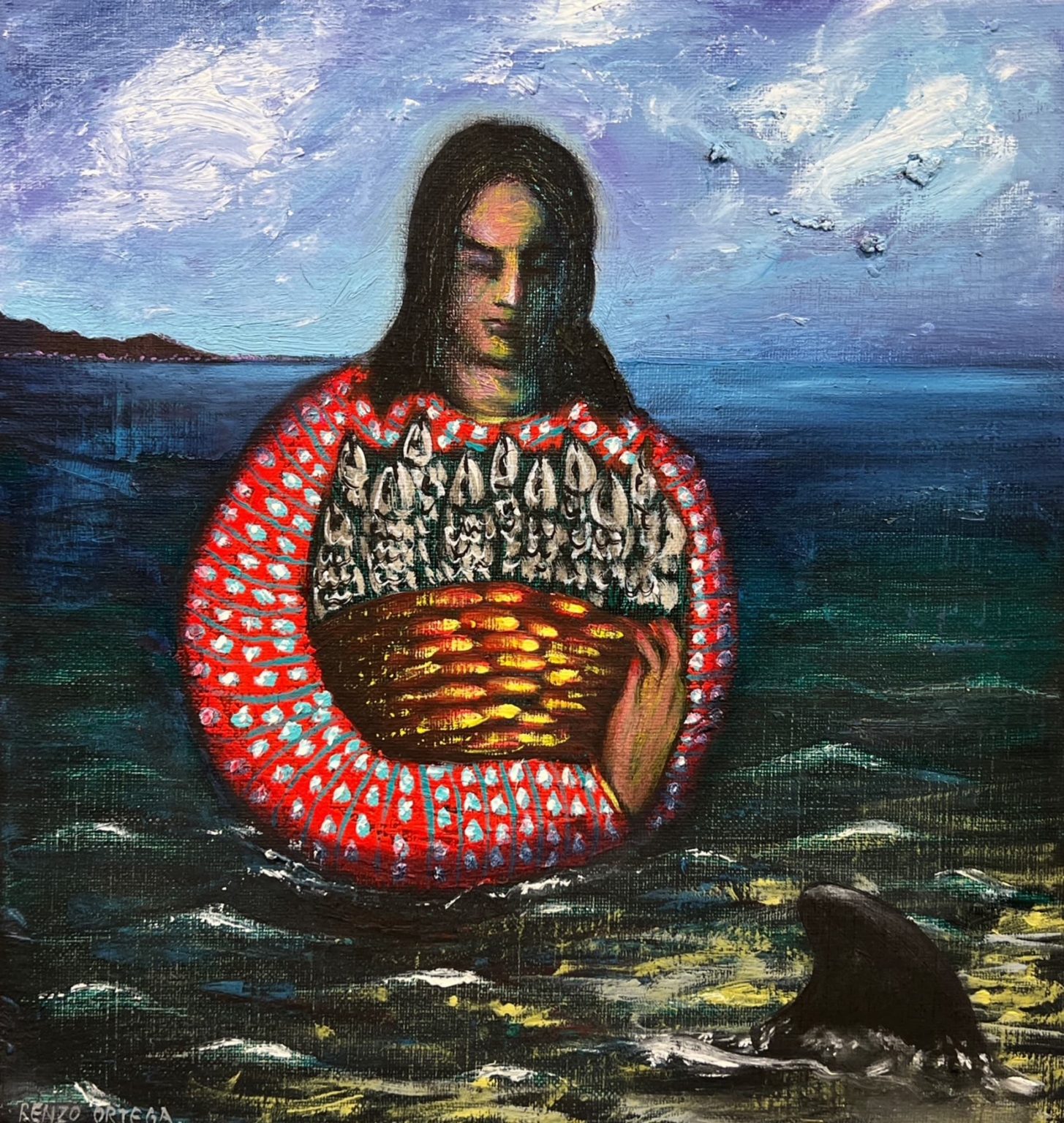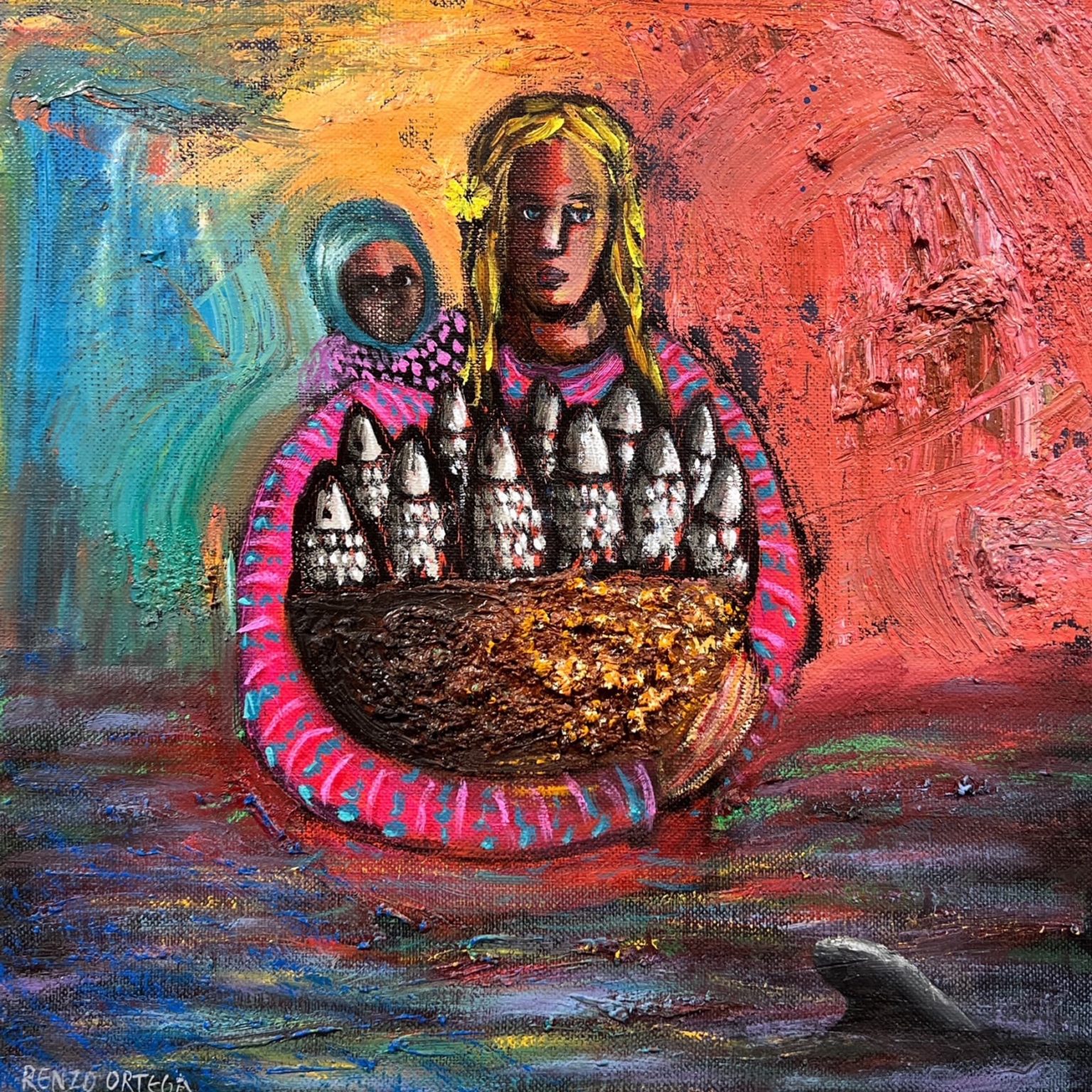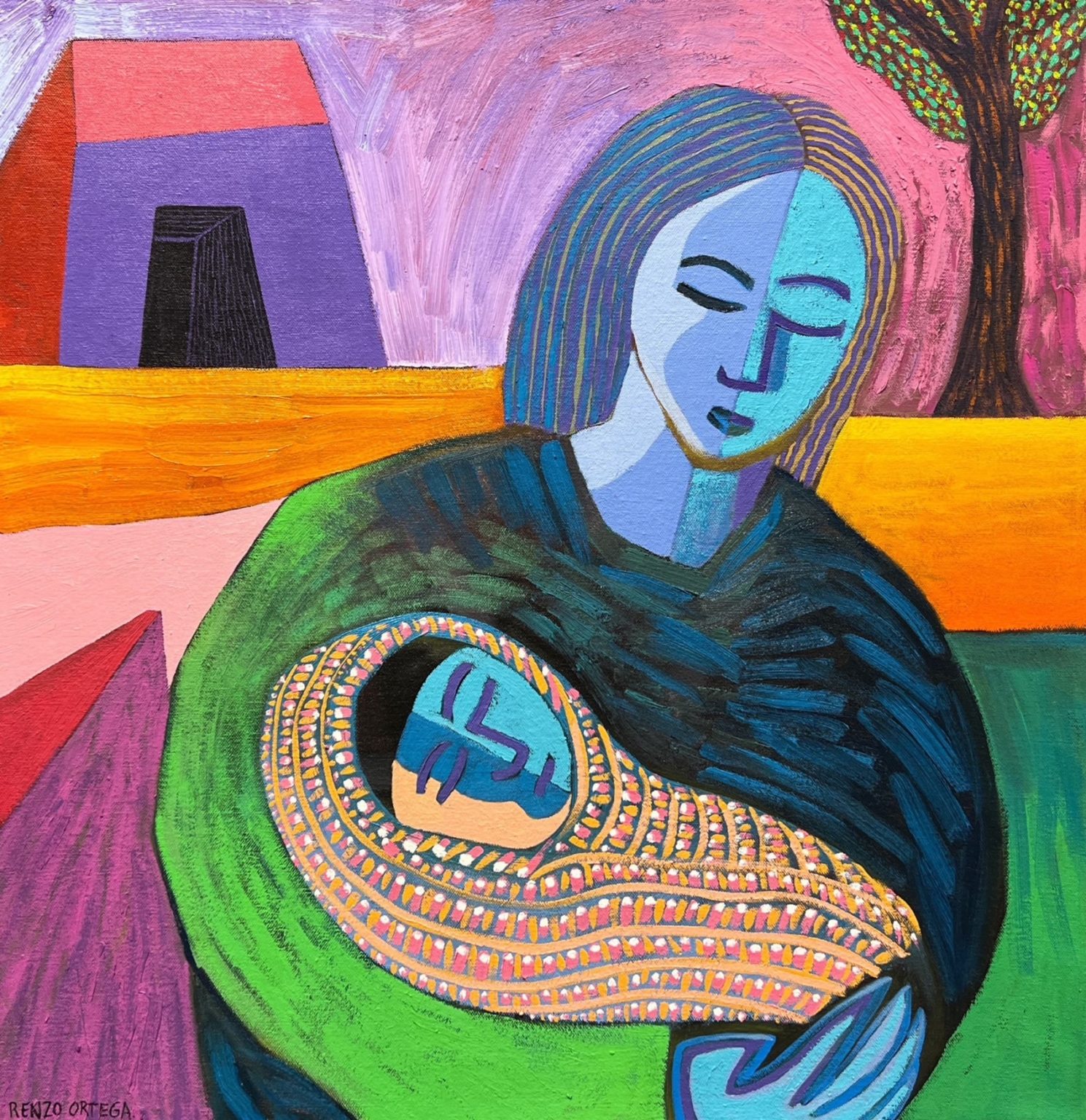RENZO ORTEGA
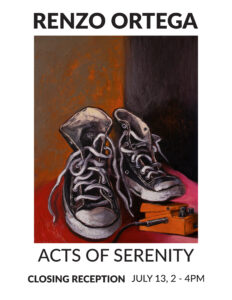
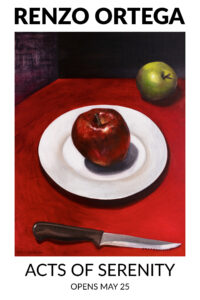
Renzo Ortega is a contemporary painter who is also a performer, musician (of techno cumbia and punk rock) and an installation artist. Best known for his fantastical compositions which incorporate elements of mythology and popular culture, Ortega takes an entirely different approach for Acts of Serenity, turning the tradition of still life painting into a meditative practice.
Ortega begins by carefully arranging and lighting the objects on a specially constructed set in his studio. He paints in silence, integrating his breath and posture with the act of applying pigment on linen. With their subtle color gradations and painterly qualities the still-lifes showcase the mastery and immediacy of his technique, and reference inspirations both historic and contemporary. In Nirvana, an old pair of Converse sneakers and a guitar pedal become a monument to Kurt Kobain, while a hat and tulip in another honor Van Gogh’s Spirit.
STATEMENT
My new body of work, a collection of still-lifes made especially for this exhibition, arises from the stimulation of ideas through observation and introspection. To achieve multidimensionality using the formal tradition of easel painting with oils, I create a set in my art studio to display the objects. I paint in silence, focus on my breathing, and with an awareness of my body posture concerning the object I paint, forming a unit with the canvas and the easel. Painting is a physical experience; my process helps to create an environment where I can materialize the intangible, capturing the essence of what I see and experience.
Painting is not just creating pictures, it is more–it is the whole art object, from the stretcher to the canvas to the paint to the brushstroke marks. I made most of these works on linen instead of cotton canvas, since linen adds a particular resonance—I like to call it a sound–to the paintings, helping to create multidimensional atmospheric spaces. After a couple of decades of painting from intuition, fantasy, and symbolic narrative, this body of work follows a different path, going hand in hand with the conventions of classical painting. That change gives me freedom, allowing me to open new doors in my work. The paintings are an invitation to an alternative world, a better world, in which I seek to receive and embrace the viewer.
I think of art as a human essence, from one’s inner being, linked to the development of thought and the spiritual. Since the beginning, painters have forged painting from the mystical path, achieving pictorial developments with discipline and mastery of the craft. A continuous mantric repetition of a physical-mental exercise, such as painting, is what I seek to embody in Acts of Serenity.
ABOUT RENZO ORTEGA
Renzo Ortega is a recipient of the 2024 Adolf and Esther Gottlieb Foundation $25,000 Individual Support Grant. The grants recognize mature artists who have made significant contributions to the arts, with careers spanning more than 20 years.
Renzo Ortega (Lima, Peru 1974) is a painter based in Carrboro, North Carolina. Renzo received a BFA in painting from the Escuela Nacional de Bellas Artes del Peru (1999), studied at the Art Students League of New York (2000-04) and has his MFA in painting from Hunter College (2014). His artwork has been exhibited in solo and group shows in the United States and Peru, and have been commissioned to create public art projects and community murals. He partook in the Visiting Artist Residency at the Rubenstein Arts Center at Duke University in 2019, and in 2020, he was the inaugural artist of the New Wave Art artist-in-residence program in West Palm Beach. Renzo is also a devoted painting and drawing teacher and has been a Visiting Lecturer at UNC Chapel Hill and a Brock Family Visiting Studio Arts Instructor at Duke University. Renzo’s artwork has been exhibited in museums such as the Cameron Museum of Art in Wilmington, the Nasher Museum of Art, Southeastern Center for Contemporary Art SECCA (Winston-Salem, the Weatherspoon Art Museum in Greensboro, in the S- Files Biennial at El Museo del Barrio in New York and the Queens International Biennial at the Queens Museum. He is a recipient of a North Carolina Arts Council Artist Fellowship Award, an Ella Fountain Pratt Emerging Artists Grant Durham Arts Council, an Orange County Arts Commission Artist Project Grant and a Queens Council on the Arts New Work Award. In 2013, as a Kossak Travel Grant recipient, Renzo traveled to Berlin to study German Expressionism, and in 2015 traveled to Honduras as a part of the U.S. Department of Cultural Affairs Cultural Envoy Program.
Other Ancestors. Stills from life and other reflections.
by Miguel Rojas-Sotelo
In Renzo Ortega’s Acts of Serenity series, we find a climatic, material, inward exploration of the value of painting as an act of reconstitution. These small paintings offer an opportunity to see Ortega’s archeological search for alternative origins.
Renzo Ortega’s (Perú 1974) work is built on the liminal space, the border of imperial traditions (Euro/American), and his roots, Peruvian immersed in Amerindian histories and aesthetics. As
a mestizo subject of the South living and working in the North, as a migrant artist, and as a male,a particular aesthetic is expected from him. For over twenty years, Ortega has kept the tension be-
tween his interest in abstract painting, baroque, and modern art with South American and Hispanic/Latino flair. For this series, Ortega has decided to recognize and pay tribute to his other ancestors: the cornerstones of modern painting, and a pictorial journey to the roots of art making. Acts of Serenity explores the genre of “Bodegón” (Still-Life), a minor but popular art expression. One advantage of the still-life art form is that it allows an artist much freedom to experiment with the arrangement of elements within the composition of a painting. Flemish artists (under colonial control by the Spanish Empire) developed the genre during the 16th and 17th centuries, allowing viewers to see everyday life through the artist’s eyes. In a sense, this genre not only shows the developments in representation via the mastery of the oil on canvas technique but also became a form of documenting the material culture of a particular time and space.
Ortega is serious and respectful of this European pictorial tradition, paying homage to the “still life” on his terms in this series. In Ortega’s large paintings, elements of 1950s abstraction, Amerin-
dian, and contemporary images coalesce. He highlights cultural differences and similarities and the constant negotiation on the constitution of the self, which materializes in the multilayer depictions that defy perspective and grounding. Acts of Serenity oscillates between material culture, art history, and painting for its own sake, expanding his previous interest in what is contained in the frame and what escapes it.
Exploring surfaces such as linen, white and black backgrounds, and oil-painting techniques such as ‘fat over lean’, ‘thick over thin’, and ‘slow-drying over fast-drying,’ Ortega offers an open book of pictorial possibilities. Throughout the series, a group of paintings is made with a limited palette, also known as grisaille, and in a Chiaroscuro style. This practice increases the drama of the subject represented, pushing it into the foreground and increasing the illusion of volume. Spanish baroque masters such as Velasquez and Murillo are well known for excelling in such painting practice. Pieces such as “Americano” (2023) and “Post Apocalyptic” (2024), which also recall the work of El Greco-known for his distorted vision and unsettled drawings, are made following these principles.
The theme comes again in “Growing Kid” (2024), where a triad of elements is in tension: a football helmet, a flower base, and a broken egg. It reminds the work of the Spanish painter Esteban Murillo (1617-1782). Murillo was also a pioneer in the genre, the first artist to paint ordinary life in the 17th century in his native town of Seville. During that time, Europe saw an extraordinary prosperity wave led by the Netherlands and its wide global commercial presence. Artists started painting everyday subjects and selling them in the open marketplace. In addition, this piece comments on Ortega’s role as a father and the passing of ancestral knowledge to the next generation.
Tension and composition are also highlighted when three elements are present in the plane. This is seen in pieces such as “Indecisions (After the Baroque)” (2024), “Spring Light” (2024), “Lemon Cure”, and “Nirvana” (a self-portrait of the artist in his alternative job as a musician). They also work as exercises of light and drawing as they expand the limited palette opening for new pieces in the series. “Lemon Cure” directly references Lucian Freud’s work, and Nirvana (tribute to Kurt Cobain) is also a good example of elements in suspension and the artist’s interest in North American abstract painting.
In other pieces, Ortega pays homage directly to pictorial forms of modernist painting, such as the ‘impasto’ and ‘alla prima” (or wet on wet) of artists such as Van Gogh and Monet. In his “Van Gogh’s Spirit” (2024), tulips a hat, and folds work in time and space. “Fresh Air,” a more relaxed, open approach to color, light, composition, and rendering comes in full form.
Ortega’s work is a game of control and randomness. Ortega is a cerebral painter with a monastic discipline and attention to detail in form and content. Carefully chooses colors (as a time travel game). And talks about culture as a container. As everything is packed, we can only see the outside, with all its visual appeal (like in a marketplace). But what is contained/constrained within? That is what matters to Ortega. As a contemporary painter, Ortega studies the history of art and the grammar of the visual to account for the fragmentation of space and time in modern societies. Ortega is also a performer, musician, and installation artist. Nonetheless, he considers himself a conventional painter with the privilege of art training at top art academies.1 Ortega feels dislocated and anachronistic as a creator, constantly searching for historical, pictorial, and personal references.
Perhaps the most direct reference to such a search for ancestrality in this series comes from the most mundane object/subject represented. In the best baroque style of Diego Velasquez (1599-1660), the Peruvian-born Ortega, living in the United States, paints with all care and conviction a potato. “Andean Power” (2024), a root vegetable that has revolutionized and changed diets across the globe. This is the best example of a counter-colonial invasion, which is as diverse as potatoes are in the Andes. A red/brown potato, not French fries.
But why Ortega’s interest in the genre? Still-life occupied the lowest rung of the hierarchy of art-making genres, but it has been extremely popular with buyers. It is a double play, a marginal genre (from a migrant/marginal subject) but with symbolic and market value. As still-life painting in this series encompasses elements ostensibly to reproduce a ‘slice of life.’ Ortega intends in almost cinematic scenes, where light, space, color, etc., are controlled to deceive the viewer into thinking the scene is real and can be contained in your preferred wall…
Miguel Rojas-Sotelo
May 23, 2024
1 Ortega received his BFA in painting from the Escuela Nacional de Bellas Artes del Perú (1999), studied at the Art Students League of New York (2000-04), and received an MFA in painting from Hunter College (2014)
Miguel Rojas-Sotelo is an art historian, visual artist, activist, scholar, and curator. He holds a Doctorate (PhD) in visual studies, contemporary art, and cultural theory from the University of Pittsburgh (2009). Miguel worked as visual arts director of the Ministry of Culture of Colombia (1995-2001) and independently as an artist, curator, filmmaker, and critic ever since. His areas of interest include: deco-
lonial aesthetics, subaltern studies, the global south, contemporary visual circuits, culture and power, Latin American visual production, cultural politics and subjectivity, performance and film studies. Rojas-Sotelo currently works and teaches at the Center for Latin American and Caribbean Studies at Duke University and is the Director of the NC Latin American Film Festival.
PAST SHOWS
CHIEKO MURASUGI & RENZO ORTEGA
SEQUENTIAL
New Paintings
May 20 – July 8
Please join us for the closing reception on Saturday, May 20th, 3-5 pm!
Renzo Ortega’s works are featured above; visit Chieko Murasugi’s gallery page to see works her works in the exhibition.
Painting is a sequential endeavor. A painting consists of a sequence of brush strokes, a series is a sequence of paintings, and a body of work is the culmination of the artist’s production. Every painter is also indebted to the long succession of painters who preceded them. In this exhibition, painters Chieko Murasugi and Renzo Ortega, arriving from very different backgrounds and pictorial approaches, create works that speak to the idea of sequence, both within the canvas and outside of it, all the while expressing their vision of what painting means at this moment.
Chieko Murasugi employs personal symbols and visual illusions within an abstract language to access the realm of ideas. She visualizes the notion of chance by using a computer program to “roll the dice” and introduce randomized elements into ordered sequences and patterns. In these paintings, selected features are randomized within both traditional and novel patterns to create a balance between predictable and unstable perceptions. Chieko frequently employs the hexagon, a Japanese symbol of longevity and a shape that holds personal significance. By chance, her parents narrowly escaped the fires from M-69 incendiary bombs dropped on Tokyo during WWII, bombs housed in hexagon shaped containers. In other paintings, Chieko incorporates the recently discovered Einstein hat shape that is based upon the hexagon and creates tile patterns that do not repeat. Lack of repetition is a crucial characteristic of randomness.
Renzo Ortega‘s painting practice consists of consistent, repetitive processes, which is how he masters his craft. Renzo believes that a constant pictorial rhythm has existed since the beginning of human existence. He relates rhythm with heartbeats and connects paintings with bodies’ frequencies. For Renzo, this consistent sequential rhythm exists in the masterworks of the history of easel painting. For example, in the drumroll-like strokes of bold impressionist brushwork, in the obsessively revisiting over and over color sequences of Van Gogh, in the endless different point of view approach on the same theme of modernism, to the tremendous progressive line of twentieth-century pictorial isms, which unleashed a free-minded contemporary painting that is the result of an infinite loop of expression through painting’s physicality.
The SEQUENTIAL exhibition invites the observer on a visual journey, generating an organic relationship between the artworks and the gallery’s visitors. Through the dynamics of color, form, ideas, and narratives, Chieko Murasugi and Renzo Ortega seek to generate a dialogue and the experience of art appreciation with the audience.
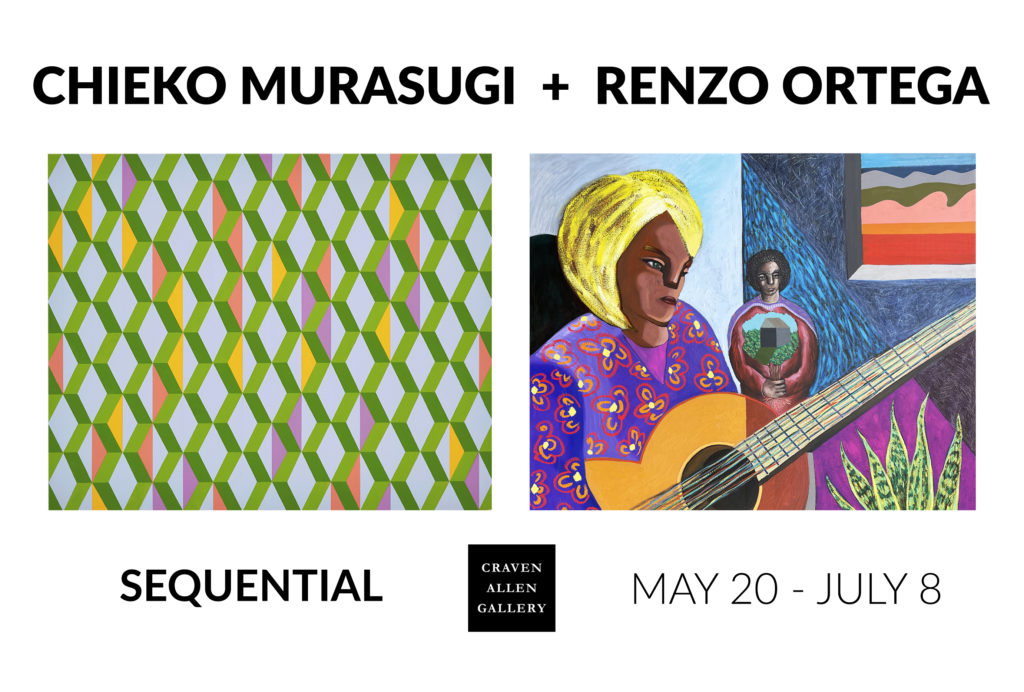
RENZO ORTEGA
STATEMENT
Art generates bonds and belongs to people’s memories. My artwork reflects the sociopolitical and geographical context where I live. In Lima-Perú, where I grew up, the Andes’ colors melt with urban chaos. I lived in a multicultural New York for 16 years. I now live in North Carolina, where the landscape view transformed the colors of my palette. These transitions have influenced my art practice; I embody freedom in the various styles that coexist in my paintings, and I believe painting is an infinite loop of life itself, a vast universe of artistic creation.
In North Carolina, I have been working on a series of paintings about my impressions of our current times. My native heritage, empowered by my immigrant experience, solidifies my American identity that connects and acknowledges the lands of the original people that have been here in the past, is part of the present, and constructs a prominent future. I believe my artworks belong to the Southern region and are part of the American Painting’s journey that started thousands of years ago, survived the European encounter, adapted to the modernist twenty-century, and are embedded now with our digital contemporaneity.
ABOUT RENZO ORTEGA
Renzo Ortega (Lima, Peru 1974) is an artist based in Carrboro, North Carolina. Renzo Received a BFA in painting from the Escuela Nacional de Bellas Artes del Peru (1999), studied at the Art Students League of New York (2000-04) and has his MFA in painting from Hunter College (2014). His artwork has been exhibited in solo and group shows in the United States and Peru, and have been commissioned to create public art projects and community murals. His recent solo exhibitions have been at TW Fine Art in Palm Beach (2022) and LUMP Gallery in Raleigh, North Carolina (2021). Renzo’s artwork has been exhibited in museums such as the NASHER Museum of Art (Durham, North Carolina, 2022), Southeastern Center for Contemporary Art SECCA (Winston-Salem, North Carolina 2020), the Works on Paper: 2017 Exhibition at The Weatherspoon Art Museum in Greensboro, in the S- Files Biennial at El Museo del Barrio (New York 2007) and Queens International Biennial at the Queens Museum in 2006. He is a recipient of the 2018-2019 North Carolina Arts Council Artist Fellowship Award, 2018- 2019 Ella Fountain Pratt Emerging Artists Grant Durham Arts Council, 2018 Orange County Arts Commission Artist Project Grant and 2016 Queens Council on the Arts New Work Award. In 2013, as a Kossak Travel Grant recipient, Renzo traveled to Berlin to study German Expressionism, and also in 2015 traveled to Honduras as a part of the U.S. Department of Cultural Affairs Cultural Envoy Program. He partook in the Visiting Artist Residency at the Rubenstein Arts Center at Duke University in 2019, and In 2020, he was the inaugural artist of the New Wave Art Wknd artist-in-residence program in West Palm Beach.
